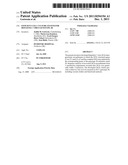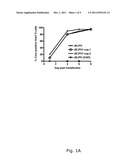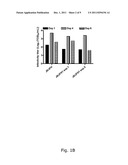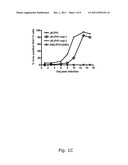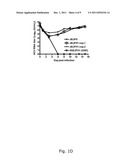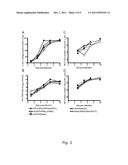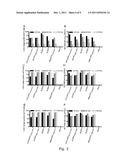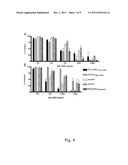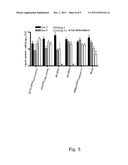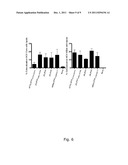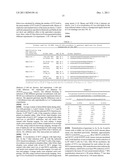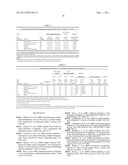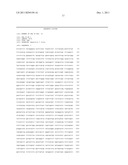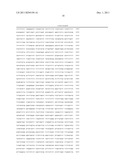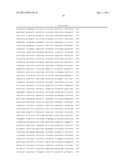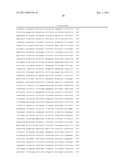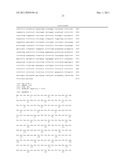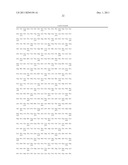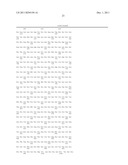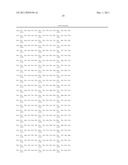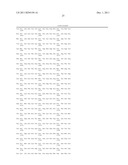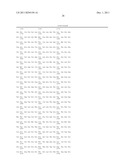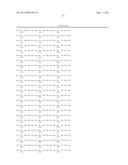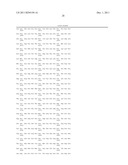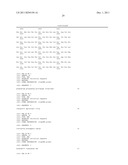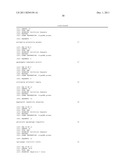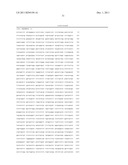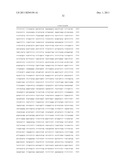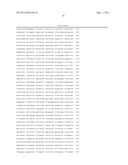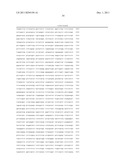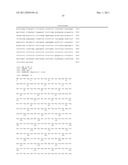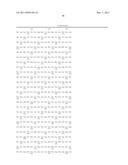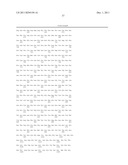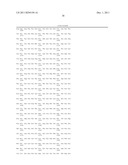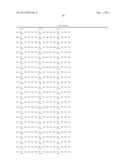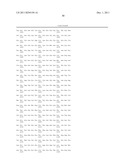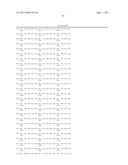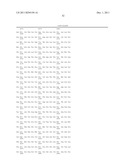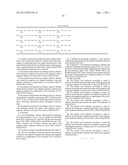Patent application title: EFFICIENT CELL CULTURE SYSTEM FOR HEPATITIS C VIRUS GENOTYPE 2B
Inventors:
Judith M. Gottwein (Frederiksberg C, DK)
Maria Lisa Knudsen (Stockholm, SE)
Troels Kasper Høyer Scheel (Kobenhavn Nv, DK)
Jens Bukh (Praesto, DK)
Jens Bukh (Praesto, DK)
Assignees:
HVIDOVRE HOSPITAL
IPC8 Class: AC12N700FI
USPC Class:
4352351
Class name: Chemistry: molecular biology and microbiology virus or bacteriophage, except for viral vector or bacteriophage vector; composition thereof; preparation or purification thereof; production of viral subunits; media for propagating
Publication date: 2011-12-01
Patent application number: 20110294194
Abstract:
The present inventors developed hepatitis C virus 2b/2a intergenotypic
recombinants in which the JFH1 structural genes (Core, E1 and E2), p7 and
the complete NS2 were replaced by the corresponding genes of the genotype
2b reference strain J8. Sequence analysis of recovered 2b/2a recombinants
from 2 transfection experiments revealed that 2b/2a was genetically
stable. Conclusion: The developed 2b/2a viruses provide a robust in vitro
tool for research in HCV genotype 2b, including vaccine studies and
functional analyses.Claims:
1. A nucleic acid molecule which encodes a human hepatitis C virus of
genotype 2b/JFH1, wherein said molecule is capable of expressing said
virus when transfected into cells and wherein said molecule encodes the
amino acid sequence with a sequence identity of at least 90% to that of
SEQ ID NO 2 and wherein the genotype 2b is strain J8.
2. The nucleic acid molecule according to claim 1, wherein said molecule comprises the nucleic acid sequence with a sequence identity of at least 90% to that of SEQ ID NO 1.
3. The nucleic acid molecule according to claim 1, wherein said molecule comprises one adaptive mutation, and said adaptive mutation is a replacement of G at position 4458 of SEQ ID NO 1 with A.
4. The nucleic acid molecule according to claim 1, wherein said molecule comprises one adaptive mutation, wherein said adaptive mutation is a replacement of R at position 1373 of SEQ ID NO 2 with Q.
5. The nucleic acid molecule according to claim 1, wherein said molecule is capable of generating a HCV infectivity titer of 10.sup.2 TCID50/ml (50% tissue culture infectious doses)/ml or above following transfection and/or subsequent viral passage.
6. The nucleic acid molecule according to claim 1, wherein said molecule encodes the amino acid sequence with a sequence identity of at least 95% to that of SEQ ID NO 2.
7. (canceled)
8. A cell comprising a nucleic acid molecule comprising the structural genes (Core, E1, E2), p7 and the non-structural gene NS2 of genotype 2b, strain J8, and the non-structural genes NS3, NS4A, NS4B, NS5A and NS5B from the JFH1 strain, wherein said molecule encodes the amino acid sequence with a sequence identity of at least 90% to that of SEQ ID NO 2.
9. The cell according to claim 8, wherein the cell is Huh7.5.
10. The cell according to claim 8, wherein said molecule comprises one adaptive mutation and wherein said adaptive mutation is a replacement of R at position 1373 of SEQ ID NO 2 with Q.
11. A method for producing a hepatitis C virus particle, comprising culturing the cell according to claim 8 to allow the cell to produce the virus.
12. A hepatitis C virus particle comprising a nucleic acid molecule comprising the structural genes (Core, E1, E2), p7 and the non-structural gene NS2 of genotype 2b, strain J8, and the non-structural genes NS3, NS4A, NS4B, NS5A and NS5B from the JFH1 strain, wherein said molecule encodes the amino acid sequence with a sequence identity of at least 90% to that of SEQ ID NO 2.
13.-15. (canceled)
16. The nucleic acid molecule according to claim 1, wherein said molecule encodes the amino acid sequence with a sequence identity of at least 98% to that of SEQ ID NO 2.
17. The nucleic acid molecule according to claim 1, wherein said molecule encodes the amino acid sequence with a sequence identity of at least 99% to that of SEQ ID NO 2.
18. The nucleic acid molecule according to claim 17, wherein said molecule comprises one adaptive mutation and wherein said adaptive mutation is a replacement of R at position 1373 of SEQ ID NO 2 with Q.
19. The nucleic acid molecule according to claim 1, wherein said molecule encodes the amino acid sequence of SEQ ID NO 2.
20. The nucleic acid molecule according to claim 1, wherein said molecule comprises the nucleic acid sequence with a sequence identity of at least 95% to that of SEQ ID NO 1.
21. The nucleic acid molecule according to claim 1, wherein said molecule comprises the nucleic acid sequence with a sequence identity of at least 99% to that of SEQ ID NO 1.
22. The nucleic acid molecule according to claim 21, wherein said molecule comprises one adaptive mutation, and said adaptive mutation is a replacement of G at position 4458 of SEQ ID NO 1 with A.
23. The nucleic acid molecule according to claim 1, wherein said molecule comprises the nucleic acid sequence of SEQ ID NO 1.
Description:
FIELD OF THE INVENTION
[0001] The present invention provides infectious recombinant hepatitis C genotype 2 viruses (HCV), and vectors, cells and animals comprising the same. The present invention provides methods of producing the infectious recombinant HCV genotype 2, and their use in identifying anti-HCV therapeutics including use in vaccines and diagnostics, as well as sequences of HCV associated with HCV pathogenesis.
BACKGROUND
[0002] Hepatitis C is one of the most widespread infectious diseases in the world. About 180 million people are infected with hepatitis C virus (HCV) worldwide with a yearly incidence of 3-4 million. While the acute phase of infection is mostly asymptomatic, the majority of acutely infected individuals develops chronic hepatitis and is at increased risk of developing liver cirrhosis and hepatocellular carcinoma. Thus, HCV infection is a major contributor to end-stage liver disease and in developed countries to liver transplantation.
[0003] HCV is a small, enveloped virus classified as a member of the Flaviviridae family. Its genome consists of a 9.6 kb single stranded RNA of positive polarity composed of 5' and 3' untranslated regions (UTR) and one long open reading frame (ORF) encoding a polyprotein, which is co- and post-translationally cleaved and thus yields the structural (Core, E1, E2), p7 and nonstructural (NS2, NS3, NS4A, NS4B, NS5A, NS5B) proteins.
[0004] HCV isolates from around the world exhibit significant genetic heterogeneity. At least 6 major HCV genotypes (genotypes 1-6) have been identified, which differ by 31-33% at the nucleotide level and deduced amino acid level. In addition, there are numerous subtypes (a, b, c, etc.), which differ by 20-25% on the nucleotide and deduced amino acid level.
[0005] While HCV genotypes 1-3 predominate in the Western World, genotypes 4-6 are more common in areas with high prevalence or even endemic levels of HCV infection. Subtypes 1b and 2b have a significant prevalence in the Western world.
[0006] While the only approved treatment for chronic HCV infection, combination therapy with interferon-α and ribavirin, leads to a sustained virologic response in most of genotype 2 or 3 patients, viral clearance is only obtained for about half of patients with genotype 1 or 4. There is no vaccine against HCV.
[0007] Since its discovery in 1989, research on HCV has been hampered by the lack of appropriate cell culture systems allowing for research on the complete viral life cycle as well as new therapeutics and vaccines.
[0008] In 2001, a genotype 2a isolate (JFH1) was described (Kato et al., 2001), which yielded high RNA titers in the replicon system without adaptive mutations (Kato et al., 2003).
[0009] A major breakthrough occurred in 2005, when formation of infectious viral particles was reported after transfection of RNA transcripts from the JFH1 full-length consensus cDNA clone into Huh7 cells (Wakita et al., 2005) (Zhong et al., 2005).
[0010] At the same time, Lindenbach et al. demonstrated that the intragenotypic 2a/2a recombinant genome (J6/JFH1), in which the structural genes (C, E1, E2), p7 and NS2 of JFH1 were replaced by the respective genes of clone J6CF, produced infectious viral particles in Huh7.5 cells (a cell line derived from bulk Huh7 cells) with an accelerated kinetic (Lindenbach et al., 2005). Cell culture derived J6/JFH viruses were apparently fully viable in vivo.
[0011] Despite the importance of the described cell culture systems they represent only a single subtype (genotype 2a) of HCV. It is important to develop cell culture systems for representative strains of other HCV genotypes, since neutralizing antibodies are not expected to cross-neutralize all genotypes and new specific antiviral compounds might have differential efficiencies against different genotypes. For the genotype specific study of the function of the structural proteins, p7 and NS2 as well as related therapeutics such as neutralizing antibodies, fusion inhibitors, ion-channel blockers and protease inhibitors, it would be sufficient to construct intergenotypic recombinant viruses in analogy to J6/JFH.
[0012] Pietschmann et al. 2006 disclose construction and characterization of infectious intra- and intergenotypic hepatitis C virus recombinants. The authors created a series of recombinant genomes allowing production of infectious genotype 1a, 1b, 2a and 3a particles by constructing intra- and intergenotypic recombinant genomes between the JFH1 isolate and the HCV isolates: H77 (genotype 1a), Con1 (genotype 1b), J6 (genotype 2a) and 452 (genotype 3a) respectively. Thus, disclosing genotype subtypes completely different from the genotype disclosed in the present application.
[0013] The infectious titers of the 1a, 1b and 3a genotypes disclosed in Pietschmann et al. 2006 are not at a level sufficiently high for practical utilization in functional analysis, drug and vaccine development or other applications. For such applications, including screening of potential drugs and development of potential vaccine candidates, the skilled person will know that infectivity titers below 103 TCID50/mL contain insufficient amounts of infectious virus.
[0014] Accordingly, the study does not attempt cell culture adaptation of the genotype recombinants, e.g. by serial passage of cell culture derived viruses to naive cells and it is not investigated whether adaptive mutations develop after transfection in cell culture. In fact, Pietschmann et al does not even provide any sequence data of the virus produced in the cell culture.
SUMMARY OF INVENTION
[0015] In this study, the present inventors used the J8 reference isolates (genotype 2b) to construct a viable, JFH1-based genome. The present inventors passaged J8/JFH1 virus in cell culture and obtained both high infectivity titers, high HCV RNA titers and identified one putative adaptive mutation.
[0016] The present inventors have developed robust cell culture systems for HCV genotype 2b. This is an important advance for the study of HCV, since it permits detailed molecular studies of HCV and enhances the potential for developing broadly reactive reagents against HCV, including but not limited to small molecule drugs, antibodies and vaccines. Accordingly, the present invention may be used for individualised treatment of patients infected with genotype 2b.
[0017] In one aspect the present invention relates to a replicating RNA comprising the structural genes (Core, E1, E2), p7 and the non-structural gene NS2 of genotype 2b and the non-structural genes NS3, NS4A, NS4B, NS5A and NS5B from the JFH1 strain.
[0018] In another aspect the present invention pertains to an isolated nucleic acid molecule which encodes human hepatitis C virus of genotype 2b/JFH1, wherein said molecule is capable of expressing said virus when transfected into cells.
[0019] In yet another aspect the present invention pertains to a composition comprising a nucleic acid molecule according to the present invention, a cassette vector for cloning viral genomes, methods for producing a cell which replicates HCV 2b/JFH1 RNA and cells obtainable there from.
[0020] In another aspect the present invention pertains to methods for producing a hepatitis C virus particle, methods for in vitro producing a hepatitis C virus-infected cell.
[0021] In a further aspect the present invention pertains to methods for screening an anti-hepatitis C virus substance, hepatitis C vaccines comprising a hepatitis C virus particle, methods for producing a hepatitis C virus vaccine and antibodies against hepatitis C virus.
DETAILED DESCRIPTION
[0022] The present invention advantageously provides hepatitis C virus (HCV) nucleotide sequences capable of replication, expression of functional HCV proteins, and infection in vivo and in vitro for development of antiviral therapeutics and diagnostics.
Nucleic Acid Molecules (cDNA Clones and RNA Transcripts)
[0023] In a broad aspect, the present invention is directed to a genetically engineered hepatitis C virus (HCV) encoded by nucleic acid sequences such as a complementary DNA (cDNA) sequence and replicating RNA (J8/JFH1) comprising the structural genes (Core, E1, E2), p7 and the non-structural gene NS2 of genotype 2b (e.g. strain J8) and the non-structural genes NS3, NS4A, NS4B, NS5A and NS5B from the JFH1 strain (genotype 2a, genbank accession number AB047639).
[0024] Thus in one embodiment, the present invention relates to a replicating RNA comprising the structural genes (Core, E1, E2), p7 and the non-structural gene NS2 of genotype 2b and the non-structural genes NS3, NS4A, NS4B, NS5A and NS5B from the JFH1 strain.
[0025] In another embodiment the genotype 2b is of the strain J8.
[0026] The invention provides an isolated nucleic acid molecule encoding an infectious recombinant HCV genome, which nucleic acids comprise an intergenotypic HCV genome. In one embodiment, the intergenotypic HCV genome comprises sequences encoding structural genes (Core, E1, E2), p7 and nonstructural genes (NS2) from a first HCV strain, and sequences encoding the 5' untranslated region (UTR), nonstructural genes NS3, NS4A, NS4B, NS5A, NS5B, and the 3' UTR from a second HCV strain.
[0027] In one embodiment, the first HCV strain and the second HCV strain are from different genotypes.
[0028] In one embodiment, the first HCV strain is strain J8, and in another embodiment, the second HCV strain is strain JFH1.
[0029] In one embodiment, the HCV nucleic acid molecule of the present invention comprises the nucleic acid sequence (cDNA) of J8/JFH1, SEQ ID NO 1. In another embodiment the nucleic acid molecule has at least a functional portion of a sequence as shown in SEQ ID NO 1 which represents a specific embodiment of the present invention exemplified herein.
[0030] In yet an embodiment the nucleic acid molecule comprises the nucleic acid sequence with a sequence identity of at least 90% to that of SEQ ID NO 1.
[0031] In another embodiment, the nucleic acid comprises a sequence sharing at least 90% identity with that set forth in SEQ ID NO 1, such as 90% identity, 91% identity, 92% identity, 93% identity, 94% identity, 95% identity, 96% identity, 97% identity, 98% identity, or 99% identity.
[0032] As commonly defined "identity" is here defined as sequence identity between genes or proteins at the nucleotide or amino acid level, respectively. Thus, in the present context "sequence identity" is a measure of identity between proteins at the amino acid level and a measure of identity between nucleic acids at nucleotide level. The protein sequence identity may be determined by comparing the amino acid sequence in a given position in each sequence when the sequences are aligned. Similarly, the nucleic acid sequence identity may be determined by comparing the nucleotide sequence in a given position in each sequence when the sequences are aligned.
[0033] To determine the percent identity of two amino acid sequences or of two nucleic acids, the sequences are aligned for optimal comparison purposes (e.g., gaps may be introduced in the sequence of a first amino acid or nucleic acid sequence for optimal alignment with a second amino or nucleic acid sequence). The amino acid residues or nucleotides at corresponding amino acid positions or nucleotide positions are then compared. When a position in the first sequence is occupied by the same amino acid residue or nucleotide as the corresponding position in the second sequence, then the molecules are identical at that position. The percent identity between the two sequences is a function of the number of identical positions shared by the sequences (i.e., % identity=# of identical positions/total # of positions (e.g., overlapping positions)×100). In one embodiment the two sequences are the same length.
[0034] One may manually align the sequences and count the number of identical amino acids. Alternatively, alignment of two sequences for the determination of percent identity may be accomplished using a mathematical algorithm. Such an algorithm is incorporated into the NBLAST and XBLAST programs of (Altschul et al. 1990). BLAST nucleotide searches may be performed with the NBLAST program, score=100, wordlength=12, to obtain nucleotide sequences homologous to a nucleic acid molecules of the invention. BLAST protein searches may be performed with the XBLAST program, score=50, wordlength=3 to obtain amino acid sequences homologous to a protein molecule of the invention. To obtain gapped alignments for comparison purposes, Gapped BLAST may be utilised. Alternatively, PSI-Blast may be used to perform an iterated search which detects distant relationships between molecules. When utilising the NBLAST, XBLAST, and Gapped BLAST programs, the default parameters of the respective programs may be used. See http://www.ncbi.nlm.nih.gov. Alternatively, sequence identity may be calculated after the sequences have been aligned e.g. by the BLAST program in the EMBL database (www.ncbi.nlm.gov/cgi-bin/BLAST). Generally, the default settings with respect to e.g. "scoring matrix" and "gap penalty" may be used for alignment. In the context of the present invention, the BLASTN and PSI BLAST default settings may be advantageous.
[0035] The percent identity between two sequences may be determined using techniques similar to those described above, with or without allowing gaps. In calculating percent identity, only exact matches are counted.
[0036] It should be noted that while SEQ ID NO 1 is a DNA sequence, the present invention contemplates the corresponding RNA sequence, and DNA and RNA complementary sequences as well.
[0037] In a further embodiment, a region from an HCV isolate is substituted for a corresponding region, e.g., of an HCV nucleic acid having a sequence of SEQ ID NO 1.
[0038] In another embodiment, the HCV nucleic acid is a DNA that codes on expression or after in vitro transcription for a replication-competent HCV RNA genome, or is itself a replication-competent HCV RNA genome.
[0039] In one embodiment, the HCV nucleic acid of the invention has a full-length sequence as depicted in or corresponding to SEQ ID NO 1. Various modifications for example of the 5' and 3' UTR are also contemplated by the invention. In another embodiment, the nucleic acid further comprises a reporter gene, which, in one embodiment, is a gene encoding neomycin phosphotransferase, Renilla luciferase, secreted alkaline phosphatase (SEAP), Gaussia luciferase or the green fluorescent protein.
[0040] Naturally, as noted above, the HCV nucleic acid sequence of the invention is selected from the group consisting of double stranded DNA, positive-sense cDNA, or negative-sense cDNA, or positive-sense RNA or negative-sense RNA or double stranded RNA. Thus, where particular sequences of nucleic acids of the invention are set forth, both DNA and corresponding RNA are intended, including positive and negative strands thereof.
[0041] In a further embodiment, the nucleic acid sequence of SEQ ID NO 1 or the said nucleic acid sequence with or without any mutation described in this document is obtained by any other means than what is described above.
[0042] In another embodiment, the complementary DNA (cDNA) provided by the present invention encodes human hepatitis C virus of genotype 2b/JFH1, wherein said molecule is capable of expressing said virus when transfected into cells and further capable of infectivity in vivo and wherein said molecule encodes the amino acid sequence of J8/JFH1, SEQ ID NO 2.
[0043] According to various aspects of the invention, HCV nucleic acid, including the polyprotein coding region, can be mutated or engineered to produce variants or derivatives with, e.g., silent mutations, conservative mutations, etc. In a further preferred aspect, silent nucleotide changes in the polyprotein coding regions (i.e., variations of the first, second or third base of a codon leading to a new codon that encodes the same amino acid) are incorporated as markers of specific HCV clones.
[0044] Thus, one aspect of the present invention relates to any of the amino acid sequences disclosed herein, such as but not limited to SEQ ID NO 2.
[0045] In yet an embodiment the isolated nucleic acid molecule encodes the amino acid sequence with a sequence identity of at least 90% to that of SEQ ID NO 2.
[0046] In another embodiment, the amino acid sequences comprises a sequence sharing at least 90% identity with that set forth in SEQ ID NO 2, such as 90% identity, 91% identity, 92% identity, 93% identity, 94% identity, 95% identity, 96% identity, 97% identity, 98% identity, or 99% identity.
[0047] It is to be understood that a sequence identity of at least 90%, such as 90% identity, 91% identity, 92% identity, 93% identity, 94% identity, 95% identity, 96% identity, 97% identity, 98% identity, or 99% identity applies to all sequences disclosed in the present application.
[0048] Nucleic acid molecules according to the present invention may be inserted in a plasmid vector for translation of the corresponding HCV RNA. Thus, the HCV DNA may comprise a promoter 5' of the 5'-UTR on positive-sense DNA, whereby transcription of template DNA from the promoter produces replication-competent RNA. The promoter can be selected from the group consisting of a eukaryotic promoter, yeast promoter, plant promoter, bacterial promoter, or viral promoter.
[0049] In one embodiment the present invention provides a cassette vector for cloning viral genomes, comprising, inserted therein, the nucleic acid sequence according to the invention and having an active promoter upstream thereof.
Adaptive Mutations
[0050] Adapted mutants of a HCV-cDNA construct or HCV-RNA full-length genome with improved abilities to generate infectious viral particles in cell culture compared to the original HCV-cDNA construct or the original HCV-RNA full-length genome are characterized in that they are obtainable by a method in which the type and number of mutations in a cell culture adapted HCV-RNA genome are determined through sequence analysis and sequence comparison and these mutations are introduced into a HCV-cDNA construct, particularly a HCV-cDNA construct according to the present invention, or into an (isolated) HCV-RNA full-length genome, either by site-directed mutagenesis, or by exchange of DNA fragments containing the relevant mutations.
[0051] In contrast to JFH1-based intergenotypic recombinants of genotypes 1a, 1b, 3a, 4a, 5a and 6a (Gottwein et al. 2007, Scheel et al. 2008, Jensen et al. in press, Gottwein et al. unpublished results), viability and efficient growth of J8/JFH1 apparently does not depend on adaptive mutations. The present inventors here report one putative adaptive mutation, which might be advantageous but apparently not necessary for efficient formation and release of viral particles in cell culture, and thus the present invention relates to this adaptive mutations in the present use as well as use in other strains by changing equivalent positions of such genomes to the adapted nucleotide or amino acid described. Efficient growth of J8/JFH1 without adaptive mutations is indeed surprising, however, could be explained by the fact that J8/JFH1 is a recombinant of two different HCV subtypes (2b and 2a) and not two different genotypes. HCV RNA and HCV infectivity titers observed in Huh7.5 cell cultures infected with J8/JFH1 viruses (Table 3 and Table 4) were comparable to those observed in cultures infected with the reference virus J6/JFH1 as well as other JFH1-based intergenotypic recombinants (e.g. genotypes 1a and 6a) developed by the present investigators. However, viability and efficient growth of intergenotypic recombinants of genotypes 1a, 1b, 3a, 4a, 5a and 6a was dependent on adaptive mutations.
[0052] The preferred HCV-cDNA construct, HCV-RNA full-length genome with the ability to release viral particles in cell culture, which is consequently highly suitable for practical use, is characterized in that it contains none or the following nucleic acid exchange and/or none or the following amino acid exchange.
[0053] In two independent RNA transfections of Huh7.5 cells, J8/JFH1 spread comparably to J6/JFH with approximately 20% and 80% HCV antigen positive cells on days 1 and 4, respectively (FIG. 1A). The supernatant infectivity titers increased from ˜101.5 TCID50/mL on day 1 to ˜103.5 TCID50/mL on day 4 (FIG. 1B). During viral passage (FIG. 1C), HCV RNA and infectivity titers were ˜107 IU/mL (FIG. 1D) and ˜104.5 TCID50/mL (data not shown; see also Table 3 and 4), respectively. Analysis of recovered viruses (days 10 and 13 post-infection, respectively) showed that J8/JFH1 was genetically stable in two first passages performed from the first transfection (data not shown and exp. 1 in FIGS. 1C and D). In the passage of virus from the second transfection (exp. 2 in FIGS. 1C and D), G4458A (R1373Q) was present as a 50/50 quasispecies with the original sequence (virus from day 13 post-infection).
[0054] One embodiment of the present invention relates to adaptive mutations, wherein the adaptive mutation is a mutation that can be observed by clonal or direct sequencing of recovered replicating genomes of SEQ ID NO 1.
[0055] Thus in a further embodiment, the present invention relates to nucleic acid molecules according to the present invention, wherein said molecule comprises none or one adaptive mutations in NS3.
[0056] In another embodiment the present invention relates to an isolated nucleic acid molecule which encodes human hepatitis C virus of genotype 2b/JFH1, wherein said molecule is capable of expressing said virus when transfected into cells and wherein said molecule encodes the nucleic acid sequence with a sequence identity of at least 90% to that of SEQ ID NO 1 and wherein the genotype 2b is strain J8.
[0057] In yet an embodiment the present invention relates to an isolated nucleic acid molecule which encodes human hepatitis C virus of genotype 2b/JFH1, wherein said molecule is capable of expressing said virus when transfected into cells and wherein said molecule encodes the nucleic acid sequence with a sequence identity of at least 90% to that of SEQ ID NO 2 and wherein the genotype 2b is strain J8.
[0058] In the context of the present invention the term "adaptive mutation" is meant to cover mutations identified in passaged J8/JFH1 viruses that provide the original J8/JFH1 and any other HCV sequence the ability to grow efficiently in culture. Furthermore all introductions of mutations into the J8/JFH1 sequences described, whether or not yielding better growth abilities, and the introduction of these mutations into any HCV sequence should be considered.
[0059] Thus the described mutation enable the HCV-RNA genome (e.g. derived from a HCV-cDNA clone) to form viral particles in and release these from suitable cell lines. In addition the described mutation might change the function of NS3 in favourable ways, which might be exploited in other experimental systems employing these proteins. This also includes other HCV genomes with adaptive mutations, all of them, combinations of them or individual mutations that grow in culture. In this case the titers might be lower than those listed.
[0060] One embodiment of the present invention relates to adaptive mutations, wherein said adaptive mutation is a replacement of G in position 4458 of SEQ ID NO 1 with A as represented in SEQ ID NO 13.
[0061] In another embodiment all the amino acid change observed herein is provided by the present application. The skilled addressee can easily obtain the same amino acid change by mutating another base of the codon and hence all means of obtaining the given amino acid sequence is intended.
[0062] An embodiment of the present invention relates to adaptive mutations, wherein said adaptive mutation is a replacement of R in position 1373 of SEQ ID NO 2 with Q as represented in SEQ ID NO 14.
Titer
[0063] To determine the efficiency of the developed system, HCV RNA titers are determined in IU/ml (international units/ml) with Taq-Man Real-Time-PCR and infectious titers are determined with a 50% tissue culture infectious dose method. This titer shows the dilution of the examined viral stock, at which 50% of the replicate cell cultures used in the essay become infected and is given in TCID50/ml. Alternatively the infectious titers are determined as FFU/ml (focus forming unites/ml) (Table 3 and 4); in this method, infectivity titers are determined by infection of cell culture replicates with serial dilutions of virus containing supernatants and, following immuno-stainings for HCV antigens, counting of HCV-antigen positive cell foci.
[0064] HCV RNA titers and infectivity titers can be determined extracellularly, in cell culture supernatant (given as IU and TCID50 or FFU per ml, respectively) or intracellularly, in lysates of pelleted cells (given as IU and TCID50 or FFU related to a given cell number, which was lysed) (Table 4).
[0065] One embodiment of the present invention relates to a nucleic acid molecule of the present invention, wherein said molecule is capable of generating a HCV RNA titer of 104 IU/ml or above following transfection and/or subsequent viral passage, such as a titer of at least 105 IU/mL, such as a titer of at least 106 IU/mL, such as a titer of at least 107 IU/mL, such as a titer of at least 108 IU/mL, such as a titer of at least 109 IU/mL, such as a titer of at least 1010 IU/mL, such as a titer of at least 1011 IU/mL, or such as a titer of at least 1012 IU/mL.
[0066] In another embodiment, the present invention relates to a nucleic acid molecule according to the invention, wherein said molecule is capable of generating a HCV infectivity titer of at least 102 TCID50/ml or above following transfection and/or subsequent viral passage, such as a titer of at least 103 TCID50/ml, such as a titer of at least 104 TCID50/ml, such as a titer of at least 105 TCID50/ml, such as a titer of at least 106 TCID50/ml, such as a titer of at least 107 TCID50/ml, such as a titer of at least 108 TCID50/ml, such as a titer of at least 109 TCID50/ml or such as a titer of at least 1010 TCID50/ml.
[0067] It is of course evident to the skilled addressee that the titers described here are obtained using the assay described in this text. Any similar or equivalent titer determined by any method is thus evidently within the scope of the present invention.
Compositions
[0068] One embodiment of the present invention relates to a composition comprising a nucleic acid molecule according to the invention suspended in a suitable amount of a pharmaceutical acceptable diluent or excipient.
[0069] In another embodiment, this invention provides for compositions comprising an isolated nucleic acid, vector or cell of this invention, or an isolated nucleic acid obtained via the methods of this invention.
[0070] In one embodiment, the term "composition" refers to any such composition suitable for administration to a subject, and such compositions may comprise a pharmaceutically acceptable carrier or diluent, for any of the indications or modes of administration as described. The active materials in the compositions of this invention can be administered by any appropriate route, for example, orally, parenterally, intravenously, intradermally, subcutaneously, or topically, in liquid or solid form.
[0071] It is to be understood that any applicable drug delivery system may be used with the compositions and/or agents/vectors/cells/nucleic acids of this invention, for administration to a subject, and is to be considered as part of this invention.
[0072] The compositions of the invention can be administered as conventional HCV therapeutics. The compositions of the invention may include more than one active ingredient which interrupts or otherwise alters groove formation, or occupancy by RNA or other cellular host factors, in one embodiment, or replicase components, in another embodiment, or zinc incorporation, in another embodiment.
[0073] The precise formulations and modes of administration of the compositions of the invention will depend on the nature of the anti-HCV agent, the condition of the subject, and the judgment of the practitioner. Design of such administration and formulation is routine optimization generally carried out without difficulty by the practitioner.
[0074] It is to be understood that any of the methods of this invention, whereby a nucleic acid, vector or cell of this invention is used, may also employ a composition comprising the same as herein described, and is to be considered as part of this invention.
[0075] "Pharmaceutically acceptable" refers to molecular entities and compositions that are physiologically tolerable and do not typically produce an allergic or similar untoward reaction, such as gastric upset, dizziness and the like, when administered to a human. Preferably, as used herein, the term "pharmaceutically acceptable" means approved by a regulatory agency of the Federal or a state government or listed in the U.S. Pharmacopoeia or other generally recognized pharmacopoeia for use in animals, and more particularly in humans.
[0076] The term "excipient" refers to a diluent, adjuvant, carrier, or vehicle with which the compound is administered. Such pharmaceutical carriers can be sterile liquids, such as water and oils, including those of petroleum, animal, vegetable or synthetic origin, such as peanut oil, soybean oil, mineral oil, sesame oil and the like. Water or aqueous solution saline solutions and aqueous dextrose and glycerol solutions are preferably employed as carriers, particularly for injectable solutions. Suitable pharmaceutical carriers are described in "Remington's Pharmaceutical Sciences" by E. W. Martin.
[0077] The term "adjuvant" refers to a compound or mixture that enhances the immune response to an antigen. An adjuvant can serve as a tissue depot that slowly releases the antigen and also as a lymphoid system activator that non-specifically enhances the immune response. Often, a primary challenge with an antigen alone, in the absence of an adjuvant, will fail to elicit a humoral or cellular immune response. Adjuvants include, but are not limited to, complete Freund's adjuvant, incomplete Freund's adjuvant, saponin, mineral gels such as aluminum hydroxide, surface active substances such as lysolecithin, pluronic polyols, polyanions, peptides, oil or hydrocarbon emulsions, keyhole limpet hemocyanins, dinitrophenol, and potentially useful human adjuvants such as BCG (bacille Calmette-Guerin) and Corynebacterium parvmm. Preferably, the adjuvant is pharmaceutically acceptable.
Cells
[0078] The nucleotides of the present invention may be used to provide a method for identifying additional cell lines that are permissive for infection with HCV, comprising contacting (e.g. transfecting) a cell line in tissue culture with an infectious amount of HCV RNA of the present invention, e.g., as produced from the plasmid clones, and detecting replication and formation and release of viral particles of HCV in cells of the cell line.
[0079] Naturally, the invention extends as well to a method for identifying an animal that is permissive for infection with HCV, comprising introducing an infectious amount of the HCV RNA, e.g., as produced by the plasmids, to the animal, and detecting replication and formation and release of viral particles of HCV in the animal. By providing infectious HCV, e.g. comprising a dominant selectable marker, the invention further provides a method for selecting for HCV with further adaptive mutations that permit higher levels of HCV replication in a permissive cell line or animal comprising contacting (e.g. transfecting) a cell line in culture, or introducing into an animal, an infectious amount of the HCV RNA, and detecting progressively increasing levels of HCV RNA and infectious HCV viral particles in the cell line or the animal.
[0080] In a specific embodiment, the adaptive mutation permits modification of HCV tropism. An immediate implication of this aspect of the invention is creation of new valid cell culture and animal models for HCV infection.
[0081] The permissive cell lines or animals that are identified using the nucleic acids of the invention are very useful, inter alia, for studying the natural history of HCV infection, isolating functional components of HCV, and for sensitive, fast diagnostic applications, in addition to producing authentic HCV virus or components thereof.
[0082] Because the HCV DNA, e.g., plasmid vectors, of the invention encode HCV components, expression of such vectors in a host cell line transfected, transformed, or transduced with the HCV DNA can be effected.
[0083] For example, a baculovirus or plant expression system can be used to express HCV virus particles or components thereof. Thus, a host cell line may be selected from the group consisting of a bacterial cell, a yeast cell, a plant cell, an insect cell, and a mammalian cell.
[0084] In one embodiment, the cell is a hepatocyte, or in another embodiment, the cell is the Huh-7 hepatoma cell line or a derived cell line such as Huh7.5, Huh7.5.1 cell line.
[0085] In one embodiment, the cell, or in another embodiment, cell systems of this invention comprise primary cultures or other, also non hepatic cell lines. "Primary cultures" refers, in one embodiment, to a culture of cells that is directly derived from cells or tissues from an individual, as well as cells derived by passage from these cells, or immortalized cells.
[0086] In one embodiment, "cell line" refers to a population of cells capable of continuous or prolonged growth and division in vitro. The term "cell lines" also includes immortalized cells. Often, cell lines are clonal populations derived from a single progenitor cell. Such cell lines are also termed "cell clones". It is further known in the art that spontaneous or induced changes can occur in karyotype during storage or transfer of such clonal populations. Therefore, cells derived from the cell clones referred to may not be precisely identical to the ancestral cells or cultures. According to the present invention, such cell clones may be capable of supporting replication of a vector, virus, viral particle, etc., of this invention, without a significant decrease in their growth properties, and are to be considered as part of this invention.
[0087] It is to be understood that any cell of any organism that is susceptible to infection by or propagation of an HCV construct, virus or viral particle of this invention is to be considered as part of this invention, and may be used in any method of this invention, such as for screening or other assays, as described herein.
[0088] Thus in one embodiment the present invention relates to a method for producing a cell which replicates HCV 2b/JFH1 RNA and produces a virus particle comprising introducing the said RNA according to the invention into a cell.
[0089] In one embodiment the present invention relates to a method for producing a cell, which replicates an RNA comprising the structural genes (Core, E1, E2), p7 and the non-structural gene NS2 of genotype 2b, strain J8, and the non-structural genes NS3, NS4A, NS4B, NS5A and NS5B from the JFH1 strain and produces a virus particle comprising introducing the said RNA into a cell wherein said RNA encodes an amino acid sequence comprising one adaptive mutation, said adaptive mutation is a replacement of R at position 1373 of SEQ ID NO 2 with Q.
[0090] In one embodiment the 2b strain is J8.
[0091] Also, a method for in vitro producing a hepatitis C virus-infected cell comprising culturing the cell which produces virus particles of the present invention and infecting other cells with the produced virus particle in the culture.
[0092] Naturally, the invention extends to any cell obtainable by such methods, for example any in vitro cell line infected with HCV, wherein the HCV has a genomic RNA sequence as described herein. Such as a hepatitis C virus infected cell obtainable by any of the methods described.
[0093] In one embodiment, the cell line is a hepatocyte cell line such as Huh7 or derived cell lines e.g. Huh7.5 or Huh7.5.1.
[0094] In another embodiment the cell is Huh7.5.
[0095] In another embodiment the cell is any cell expressing the genes necessary for HCV infection and replication, such as but not limited to CD81, SR-BI, Claudin-1, -4, -6 or -9 and the low-density lipid receptor.
[0096] Importance of CD81 for HCV entry has in previous studies been shown for pseudoviral particles (HCVpp) of genotypes 1-6, and for cell culture derived HCV (HCVcc) of genotypes 1a (H77), 1b (Con-1), 3a (S52), 4a (ED43) and 5a (SA13). Blocking of SR-BI receptors was found to inhibit infection with HCVpp of genotypes 1-6. In the HCVcc system, genotypes 2a and 5a in previous studies depended on SR-BI. In comparative studies, the present investigators showed that entry of genotypes 1, 2 and 6 was efficiently inhibited when relative high doses of blocking antibodies against the respective HCV co-receptor were used (FIG. 4). Thus, CD81 and SR-BI play an important role for entry of prototype isolates of the six major genotypes and important subtypes 1b and 2b. Future studies will be required to determine if the different levels of inhibition seen at lower antibody doses are due to stochastical effects or indicate different modes of entry.
[0097] The invention further provides various methods for producing HCV virus particles, including by isolating HCV virus particles from the HCV-infected non-human animal of invention; culturing a cell line of the invention under conditions that permit HCV replication and virus particle formation; or culturing a host expression cell line transfected with HCV DNA under conditions that permit expression of HCV particle proteins; and isolating HCV particles or particle proteins from the cell culture. The present invention extends to an HCV virus particle comprising a replication-competent HCV genome RNA, or a replication-defective HCV genome RNA, corresponding to an HCV nucleic acid of the invention as well.
Virus Particle
[0098] The production of authentic virus proteins (antigens) may be used for the development and/or evaluation of diagnostics. The cell culture system according to the invention also allows the expression of HCV antigens in cell cultures. In principle these antigens can be used as the basis for diagnostic detection methods.
[0099] The production of HCV viruses and virus-like particles, in particular for the development or production of therapeutics and vaccines as well as for diagnostic purposes is an embodiment of the present invention. Especially cell culture adapted complete HCV genomes, which could be produced by using the cell culture system according to the invention, are able to replicate and form viral particles in cell culture with high efficiency. These genomes have the complete functions of HCV and in consequence they are able to produce infectious viruses.
[0100] Thus in one embodiment the present invention relates to a method for producing a hepatitis C virus particle of the present invention or parts thereof, comprising culturing a cell or an animal to allow either to produce the virus.
[0101] In another embodiment the inventions provides a hepatitis C virus particle obtainable by the method described.
[0102] Because the invention provides, inter alia, infectious HCV RNA, the invention provides a method for infecting an animal with HCV which comprises administering an infectious dose of HCV RNA, such as the HCV RNA transcribed from the plasmids described above, to the animal. Naturally, the invention provides a non-human animal infected with HCV of the invention, which non-human animal can be prepared by the foregoing methods.
[0103] A further advantage of the present invention is that, by providing a complete functional HCV genome, authentic HCV viral particles or components thereof, which may be produced with native HCV proteins or RNA in a way that is not possible in subunit expression systems, can be prepared.
[0104] In addition, since each component of HCV of the invention is functional (thus yielding the authentic HCV), any specific HCV component is an authentic component, i.e., lacking any errors that may, at least in part, affect the clones of the prior art. Indeed, a further advantage of the invention is the ability to generate HCV virus particles or virus particle proteins that are structurally identical to or closely related to natural HCV virions or proteins. Thus, in a further embodiment, the invention provides a method for propagating HCV in vitro comprising culturing a cell line contacted with an infectious amount of HCV RNA of the invention, e.g., HCV RNA translated from the plasmids described above, under conditions that permit replication of the HCV RNA.
[0105] Further the viability of the developed viruses may be determined in vivo, either in SCID-uPA mice engrafted with human liver tissue or in chimpanzees as shown in Lindenbach et al. 2006.
[0106] In one embodiment, the method further comprises isolating infectious HCV. In another embodiment, the method further comprises freezing aliquots of said infectious HCV. According to this aspect of the invention, and in one embodiment, the HCV is infectious following thawing of said aliquots, and in another embodiment, the HCV is infectious following repeated freeze-thaw cycles of said aliquots.
[0107] Screening for anti-viral drugs and the determination of drug resistance.
[0108] It can be assumed that resistance to therapy occurs due to the high mutation rate of the HCV genome. This resistance, which is very important for the clinical approval of a substance, can be detected with the cell culture system according to the invention. Cell lines, in which the HCV-RNA construct or the HCV genome or subgenome replicates and produces infectious viral particles, are incubated with increasing concentrations of the relevant substance and the replication of the viral RNA is either determined by means of an introduced reporter gene or through the qualitative or quantitative detection of the viral nucleic acids or proteins. The release of viral particles is determined by measuring HCV RNA and infectivity titers in the cell culture supernatant. Resistance is given if no or a reduced inhibition of the replication and release of viral particles can be observed with the normal concentration of the active substance. The nucleotide and amino acid replacements responsible for the therapy resistance can be determined by recloning the HCV-RNA (for example by the means of RT-PCR) and sequence analysis. By cloning the relevant replacement(s) into the original construct its causality for the resistance to therapy can be proven.
[0109] While the replicon systems facilitated testing of drugs interfering with replication such as NS3/4A protease and polymerase inhibitors, the variant genomes obtained in the present invention may prove useful for different research topics. Genomes with the original J8 Core could be applied to examine genotype 2b specific features of Core.
[0110] The systems developed in this invention are ideal candidates for genotype 2b specific testing of therapeutics in general and therapeutics targeting viral entry, assembly and release. Genomes with the J8 sequences are valuable for testing of neutralizing antibodies and other drugs acting on entry level, such as fusion inhibitors.
[0111] The present inventors conducted cross-genotype neutralization studies in HCV cell culture systems recapitulating the entire viral life cycle using JFH1-based viruses with envelope sequences of all 6 major genotypes and the important subtypes 1b and 2b, which has previously not been possible (Table 2). HCV E1/E2 assembled on HCV pseudo particles (HCVpp), used in previous neutralization studies could show an unphysiological confirmation, glycosylation pattern and/or lipoprotein association due to the nature of the HCVpp as well as the non-hepatic producer cell-lines used in such experiments.
[0112] In such studies the viral particles are incubated with the neutralizing substance, e.g. patient derived antibodies present in serum, prior to incubation with cells permissive and susceptible to viral infection. The neutralizing effect, i.e. the inhibitory effect on viral entry, is measured e.g. by relating the number of focus forming units (FFUs, defined as foci of adjacent infected cells) to the equivalent count in a control experiment done under same circumstances without the active inhibitor molecule.
[0113] The inventors of the present invention showed that JFH1-based viruses of the genotype 1a, 1b, 2b, 4a, 5a, 6a and 7a were efficiently neutralized by chronic phase H06 genotype 1a serum derived from reference Patient H (Table 2). The results in the cell culture systems compare well to neutralization experiments using Patient H serum from year 26 (H03) carried out in HCVpp systems with envelope proteins of the same prototype isolates of all 6 HCV genotypes as used in the present application, and heterogeneity between the genotypes is thus as previously reported by Meunier et al. 2005.
[0114] In addition the present inventors found that cross-genotype neutralization extended to a chronic phase genotype 4a serum (AA), which efficiently neutralized genotype 2b, 4a, 5a, 6a and 7a (Table 2). Also, the cross-genotype neutralization extended to a chronic phase genotype 5a serum (SA3), which efficiently neutralized genotype 2b, 4a, 5a, 6a and 7a (Table 2). It is of note that genotypes subtypes 2a and 2b, which belong to the same genotype and genotypes 2b and 7a, which have, for isolates of different major genotypes, a relatively high sequence homology, differ in their susceptibility to neutralization.
[0115] Accordingly, the JFH1-based cell culture systems which have been developed for HCV genotype 1a, 1b, 2a, 2b, 3a, 4a, 5a, 6a and 7a provide a valuable tool for efficiently screening for and identifying new candidate HCV genotype 1a, 1b, 2a, 2b, 3a, 4a, 5a, 6a and 7a inhibitors e.g. of entry e.g. in serum derived from infected patients. Accordingly this invention, allows identification and raise of cross-neutralizing antibodies, which is important for the development of active and passive immunization strategies. Furthermore the availability of cell culture grown HCV particles bearing envelope proteins of the six major genotypes enables the development of inactivated whole virus vaccines and comprehensive virus neutralization studies.
[0116] In one embodiment the present invention relates to a method for identifying neutralizing antibodies.
[0117] In another embodiment the present invention relates to a method for identifying cross-genotype neutralizing antibodies.
[0118] In one embodiment the present invention relates to a method of raising neutralizing antibodies.
[0119] In another embodiment the present invention relates to a method of raising cross-neutralizing antibodies.
[0120] In one embodiment the present invention related to a method for screening new HCV genotype 1a, 1b, 2a, 2b, 3a, 4a, 5a, 6a and/or 7a inhibitors or neutralizing antibodies, comprising [0121] a) culturing at least one selected from the group consisting of a cell according to the present invention, a hepatitis C virus infected cell according to the present invention and a hepatitis C virus particle obtainable by the present invention together with a hepatitis C virus permissive cell, and [0122] b) subjecting said virus or virus infected cell culture to a blood sample or derivatives thereof from a HCV genotype 1a, 1b, 2a, 2b, 3a, 4a, 5a, 6a and/or 7a infected patient [0123] c) detecting the amount of replicating RNA and/or the virus particles.
[0124] The p7 peptide features two transmembrane domains (TM1 and TM2), and p7 monomers multimerize to form a putative ion channel. Additionally p7 has been shown to contain genotype specific sequences required for genotype specific interactions between p7 and other HCV proteins. Hence, new compounds targeting the putative p7 ion-channel and autoprotease inhibitors interfering with NS2, and drugs targeting cellular proteins involved in the described processes can be tested.
[0125] The inventors of the present invention showed that JFH1-based viruses can be used for testing putative anti-HCV antivirals. Huh7.5 cultures infected with JFH1-based recombinants of genotypes 1a, 1b, 2a, 2b, and 6a were treated with 500 IU/mL interferon-α2b (FIG. 3A, B), 20 μM ribavirin (FIG. 3C, D) or 50 μM amantadine (FIG. 3E, F), respectively. A combination of interferon-α2b and ribavirin is the only currently licensed treatment of HCV infected patients. While sustained viral response (SVR) can be achieved in 80-90% of genotype 2 and 3 infected patients treated with this combination therapy, SVR is only seen in 40-50% of genotype 1 and 4 infected patients. Sequence differences of several genome regions, especially E2 and NS5A, are suggested to be responsible for this differential response. The ion-channel blocker amantadine is used in treatment of influenza and has been suggested to block HCV p7. At the tested concentrations, no significant cytotoxic effect was observed. After 72 hrs of interferon-α2b treatment, an >60% decrease in the number of infected cells and a ˜2 log decrease in supernatant HCV RNA titers was observed (FIG. 3A, B). Treatment with ribavirin and amantadine had no apparent effect (FIGS. 3C-F). This is in line with previous studies, in which interferon decreased replication of J6/JFH, whereas ribavirin and amantadine did not decrease production of infectious virus in JFH1 cultures or cultures with genotype 1a (H77), 1b (Con1) or 2a (J6) JFH1-based recombinants. Genotype specific susceptibility to interferon-α2 in patients was attributed different genome regions, especially in E2 and NS5A. With the relatively high doses used for treatment of genotype 1-6 infected cultures, we did not observe any genotype specific effect; in future studies, it will be of interest to test different interferon doses and different HCV isolates, preferably from patients showing different responses to interferon. Differential sensitivity to interferon could also be mediated by the UTRs or NS3 to NS5B proteins, which are genotype 2a specific in all the recombinants tested. In conclusion, the developed systems can be applied to test the antiviral potential of known and newly developed therapeutics and to test, which HCV genome regions mediated resistance to treatment.
[0126] Thus, one embodiment of the present invention relates to a method for screening an anti-hepatitis C virus substance, comprising [0127] a) culturing at least one selected from the group consisting of a cell according to the present invention, a hepatitis C virus infected cell according to the present invention and a hepatitis C virus particle obtainable by the present invention together with a hepatitis C virus permissive cell, [0128] b) subjecting said virus or virus infected cell culture to the anti-hepatitis C virus substance, and [0129] c) detecting the replicating RNA and/or the virus particles in the resulting culture.
[0130] In another embodiment, the inhibition of HCV replication and/or infection and/or pathogenesis includes inhibition of downstream effects of HCV. In one embodiment, downstream effects include neoplastic disease, including, in one embodiment, the development of hepatocellular carcinoma.
[0131] In one embodiment, the invention provides a method of screening for anti-HCV therapeutics, the method comprising contacting a cell with an isolated nucleic acid molecule encoding an infectious recombinant HCV genome, comprising a chimeric HCV genome and contacting the cell with a candidate molecule, independently contacting the cell with a placebo and determining the effects of the candidate molecule on HCV infection, replication, or cell-to-cell spread, versus the effects of the placebo, wherein a decrease in the level of HCV infection, replication, or cell-to-cell spread indicates the candidate molecule is an anti-HCV therapeutic.
[0132] In one embodiment, the method may be conducted be in vitro or in vivo. In one embodiment, the cells as described may be in an animal model, or a human subject, entered in a clinical trial to evaluate the efficacy of a candidate molecule. In one embodiment, the molecule is labelled for easier detection, including radio-labelled, antibody labelled for fluorescently labelled molecules, which may be detected by any means well known to one skilled in the art.
[0133] In one embodiment, the candidate molecule is an antibody.
[0134] In one embodiment, the term "antibody" refers to intact molecules as well as functional fragments thereof, such as Fab, F(ab')2, and Fv. In one embodiment, the term "Fab" refers to a fragment, which contains a monovalent antigen-binding fragment of an antibody molecule, and in one embodiment, can be produced by digestion of whole antibody with the enzyme papain to yield an intact light chain and a portion of one heavy chain, or in another embodiment can be obtained by treating whole antibody with pepsin, followed by reduction, to yield an intact light chain and a portion of the heavy chain. In one embodiment, the term "F(ab')2", refers to the fragment of the antibody that can be obtained by treating whole antibody with the enzyme pepsin without subsequent reduction, F(ab')2 is a dimer of two Fab' fragments held together by two disulfide bonds. In another embodiment, the term "Fv" refers to a genetically engineered fragment containing the variable region of the light chain and the variable region of the heavy chain expressed as two chains, and in another embodiment, the term "single chain antibody" or "SCA" refers to a genetically engineered molecule containing the variable region of the light chain and the variable region of the heavy chain, linked by a suitable polypeptide linker as a genetically fused single chain molecule.
[0135] Methods of producing these fragments are known in the art.
[0136] In another embodiment, the candidate molecule is a small molecule. In one embodiment, the phrase "small molecule" refers to, inter-alia, synthetic organic structures typical of pharmaceuticals, peptides, nucleic acids, peptide nucleic acids, carbohydrates, lipids, and others, as will be appreciated by one skilled in the art. In another embodiment, small molecules, may refer to chemically synthesized peptidomimetics of the 6-mer to 9-mer peptides of the invention.
[0137] In another embodiment, the candidate molecule is a nucleic acid. Numerous nucleic acid molecules can be envisioned for use in such applications, including antisense, siRNA, ribozymes, etc., as will be appreciated by one skilled in the art.
[0138] It is to be understood that the candidate molecule identified and/or evaluated by the methods of this invention, may be any compound, including, inter-alia, a crystal, protein, peptide or nucleic acid, and may comprise an HCV viral product or derivative thereof, of a cellular product or derivative thereof. The candidate molecule in other embodiments, may be isolated, generated synthetically, obtained via translation of sequences subjected to any mutagenesis technique, or obtained via protein evolution techniques, well known to those skilled in the art, each of which represents an embodiment of this invention, and may be used in the methods of this invention, as well.
[0139] In one embodiment, the compound identified in the screening methods as described, may be identified by computer modeling techniques, and others, as described herein. Verification of the activity of these compounds may be accomplished by the methods described herein, where, in one embodiment, the test compound demonstrably affects HCV infection, replication and/or pathogenesis in an assay, as described. In one embodiment, the assay is a cell-based assay, which, in one embodiment, makes use of primary isolates, or in another embodiment, cell lines, etc. In one embodiment, the cell is within a homogenate, or in another embodiment, a tissue slice, or in another embodiment, an organ culture. In one embodiment, the cell or tissue is hepatic in origin, or is a derivative thereof. In another embodiment, the cell is a commonly used mammalian cell line, which has been engineered to express key molecules known to be, or in another embodiment, thought to be involved in HCV infection, replication and/or pathogenesis.
[0140] In another embodiment, protein, or in another embodiment, peptide or in another embodiment, other inhibitors of the present invention cause inhibition of infection, replication, or pathogenesis of HCV in vitro or, in another embodiment, in vivo when introduced into a host cell containing the virus, and may exhibit, in another embodiment, an IC50 in the range of from about 0.0001 nM to 100 μM in an in vitro assay for at least one step in infection, replication, or pathogenesis of HCV, more preferably from about 0.0001 nM to 75 μM, more preferably from about 0.0001 nM to 50 μM, more preferably from about 0.0001 nM to 25 μM, more preferably from about 0.0001 nM to 10 μM, and even more preferably from about 0.0001 nM to 1 μM.
[0141] In another embodiment, the inhibitors of HCV infection, or in another embodiment, replication, or in another embodiment, pathogenesis, may be used, in another embodiment, in ex vivo scenarios, such as, for example, in routine treatment of blood products wherein a possibility of HCV infection exists, when serology shows a lack of HCV infection.
[0142] In another embodiment, the anti-HCV therapeutic compounds identified via any of the methods of the present invention can be further characterized using secondary screens in cell cultures and/or susceptible animal models. In one embodiment, a small animal model may be used, such as, for example, a tree shrew Tupaia belangeri chinensis. In another embodiment, an animal model may make use of a chimpanzee. Test animals may be treated with the candidate compounds that produced the strongest inhibitory effects in any of the assays/methods of this invention. In another embodiment, the animal models provide a platform for pharmacokinetic and toxicology studies.
Vaccines
[0143] The construct according to the invention by itself can also be used for various purposes in all its embodiments. This includes the construction of hepatitis C viruses or HCV-like particles and their production in cell cultures as described.
[0144] These HCV or HCV-like particles can be used in particular as vaccine. Thus, one embodiment of the present invention relates to a hepatitis C vaccine comprising a hepatitis C virus particle according to the invention or a part thereof.
[0145] In another embodiment, the nucleic acids, vectors, viruses, or viral particles may be further engineered to express a heterologous protein, which, in another embodiment, is mammalian or a derivative thereof, which is useful in combating HCV infection or disease progression. Such proteins may comprise cytokines, growth factors, tumor suppressors, or in one embodiment, may following infection, be expressed predominantly or exclusively on an infected cell surface. According to this aspect of the invention, and in one embodiment, such molecules may include costimulatory molecules, which may serve to enhance immune response to infected cells, or preneoplastic cells, or neoplastic cells, which may have become preneoplastic or neoplastic as a result of HCV infection. In one embodiment, the heterologous sequence encoded in the nucleic acids, vectors, viruses, or viral particles of this invention may be involved in enhanced uptake of a nucleic acids, vectors, viruses, or viral particles, and may specifically target receptors thought to mediate HCV infection.
[0146] Further, the present invention relates to a method for producing a hepatitis C virus vaccine comprising using a hepatitis C virus particle according to the invention as an antigen, and naturally any antibody against such hepatitis C virus particle.
Uses
[0147] The genotype 2b cell culture system developed of the present invention will be a valuable tool to address different research topics. It will allow the genotype specific study of functions of the structural proteins (Core, E1, E2) as well as p7 and NS2 using reverse genetics. While the replicon systems facilitated testing of drugs interfering with replication such as NS3/4A protease and polymerase inhibitors, the system developed in this study is ideal for the genotype 2b specific testing of new drugs, such as drugs interfering with viral entry, such as fusion inhibitors, as well as assembly and release.
[0148] Accordingly the genotype 2b developed cell culture systems allows individual patient targeting. This means that when a new potential therapeutic candidate is discovered it is possible to test this particular candidate or combination of candidates on this genotype. Knowing which specific genotype the candidate is functioning towards, it allows an individual treatment of each patient dependent on which specific genotype the patient is infected with. Furthermore these cell culture systems allow the development of antibodies and vaccines targeting individual patients.
[0149] In addition new therapeutics targeting the putative p7 ion-channel and protease inhibitors targeting NS2 can be tested specifically for genotype 2b thus allowing individual patient targeting.
[0150] J8/JFH1 recombinant viruses will be well suited for screenings for broadly reactive neutralizing antibodies, thus aiding vaccine development.
[0151] The replication level of a virus can be determined, in other embodiments, using techniques known in the art, and in other embodiments, as exemplified herein. For example, the genome level can be determined using RT-PCR. To determine the level of a viral protein, one can use techniques including ELISA, immunoprecipitation, immunofluorescence, EIA, RIA, and Western blotting analysis. To determine the replication rate of a virus, one can use the method described in, e.g., Billaud et al., Virology 266 (2000) 180-188.
[0152] In one embodiment, the invention provides a method of identifying sequences in HCV associated with HCV pathogenicity, comprising contacting cells with an isolated nucleic acid molecule encoding an infectious recombinant HCV genome, comprising a chimeric HCV genome, contacting cells with an isolated nucleic acid molecule comprising at least one mutation of the chimeric HCV genome, independently culturing the cells and determining HCV infection, replication, or cell-to-cell spread, in cells contacted with the mutant, versus the chimeric HCV, whereby changes in HCV infection, replication, or cell-to-cell spread in cells contacted with the mutant virus shows the mutation is in an HCV sequence associated with HCV pathogenicity.
[0153] In one embodiment, the invention provides a method of identifying HCV variants with improved growth in cell culture, the method comprising contacting cells with an isolated nucleic acid molecule encoding an infectious recombinant HCV genome, comprising a chimeric HCV genome contacting cells with an isolated nucleic acid molecule comprising or not comprising mutations of the chimeric HCV genome, independently culturing the cells and determining HCV infection, replication, or cell-to-cell spread, in cells contacted with the chimeric HCV or the mutated virus, whereby enhanced HCV infection, replication, or cell-to-cell spread in cells contacted with the mutated virus shows that the HCV variant has improved growth in cell culture. In some embodiments, HCV variants are selected for enhanced replication, over a long course of time, in vitro culture systems. According to this aspect of the invention, and in some embodiments, cells contacted with the variants are characterized by reduced infection, as compared to cells contacted with the chimeric HCV.
[0154] The developed systems can be used to quantify HCV proteins as well as their influence on and interaction with host cell factors. In the present invention, the inventors used confocal microscopy based image analysis to quantify HCV Core and NS5A protein, the amount of intracellular lipids and interaction of Core and NS5A with intracellular lipids. The inventors evaluated spread of in vitro HCV infection by quantitative confocal microscopy based imaging. In a blinded study, increasing amounts of Core and NS5A relative to the number of total cells were detected during days 3-10 for genotype 1, 2 and 6 recombinants (FIG. 2C, D), suggesting that this methodology could be an effective tool to evaluate HCV infection in vitro. The method also readily detected a nonspecific background staining with the anti-Core antibody, whereas the anti-NS5A gave no such signal. Thus, for optimization this quantification method requires attention to the selection of antibodies for immunostaining.
[0155] The HCV lifecycle depends on the lipid metabolism and Core has been suspected to induce hepatocellular steatosis in genotype 3 patients. In the present invention, big variation in the lipid content of non-infected Huh7.5 cells was found; during 10 days, infection with genotype 1, 2 and 6 recombinants did not induce intracellular lipid accumulation (FIG. 5), and no genotype specific differences in lipid content were found at peak infection (Table 4). A short-term infection in cell culture might not induce the changes in lipid metabolism leading to steatosis in chronically infected patients. Even though the inventors analyzed an average of 660 cells per culture for each time-point, it is evident that there was variation in the lipid content in infected as well as non-infected cells, which might mask possible subtle differences in lipid content induced by HCV. Furthermore, the inventors based their analysis on quantification of fluorescent intensity to quantify the total amount of lipids in the cell cytoplasm. Thus, morphological differences of lipid droplets between infected and non-infected cells were not analysed, which has been carried out in HCV infected cells by electron microscopy and in HCV Core expressing cells by confocal microscopy.
[0156] The present inventors found HCV Core to co-localize with lipid droplets for genotype 1, 2 and 6 recombinants (FIG. 6) as described by others for genotype 2a; further, co-localization of NS5A with lipid droplets was detected for genotype 1, 2 and 6 recombinants (FIG. 6), indicating either a direct or Core-mediated association. Interestingly, the interaction of NS5A with Core was found to play an important role in regulating the early phase of HCV particle formation.
Kits
[0157] In a related aspect, the invention also provides a test kit for HCV comprising HCV virus components, and a diagnostic test kit for HCV comprising components derived from an HCV virus as described herein.
[0158] Furthermore the invention also provide test kits, for screening for new HCV genotype 2b inhibitors, neutralizing and cross neutralizing antibodies, comprising HCV virus components.
General
[0159] Reference to any prior art in this specification is not, and should not be taken as, an acknowledgment or any form of suggestion that this prior art forms part of the common general knowledge in any country.
[0160] All patent and non-patent references cited in the present application, are hereby incorporated by reference in their entirety.
[0161] As will be apparent, preferred features and characteristics of one aspect of the invention may be applicable to other aspects of the invention. The invention may be embodied in other specific forms without departing from the spirit or essential characteristics thereof. The foregoing embodiments are therefore to be considered in all respects illustrative rather than limiting on the invention described herein. Scope of the invention is thus showed be the appended claims rather than by the foregoing description, and all changes that come within the meaning and range of equivalency of the claims are intended to be embraced by reference therein.
[0162] Throughout this specification the word "comprise", or variations such as "comprises" or "comprising", will be understood to imply the inclusion of a stated element, integer or step, or group of elements, integers or steps, but not the exclusion of any other element, integer or step, or group of elements, integers or steps.
[0163] In addition, singular reference does not exclude a plurality. Thus, references to "a", "an", "first", "second" etc. do not preclude a plurality.
[0164] The invention may be embodied in other specific forms without departing from the spirit or essential characteristics thereof. The foregoing embodiments are therefore to be considered in all respects illustrative rather than limiting on the invention described herein. Scope of the invention is thus showed be the appended claims rather than by the foregoing description, and all changes that come within the meaning and range of equivalency of the claims are intended to be embraced by reference therein.
[0165] The invention will hereinafter be described by way of the following non-limiting Figures and Examples.
TABLE-US-00001 Sequences DNA/amino SEQ ID NO acid (AA) Name SEQ ID NO 1 DNA J8/JFH1 SEQ ID NO 2 AA J8/JFH1 SEQ ID NO 3 DNA -84S_HCV-MOD SEQ ID NO 4 DNA J8 R1458 fus SEQ ID NO 5 DNA J8 F1286 fus SEQ ID NO 6 DNA J8R2309 SEQ ID NO 7 DNA J8F1989 SEQ ID NO 8 DNA J8 R3003 SEQ ID NO 9 DNA J8F2762 SEQ ID NO 10 DNA 3774R_J6 SEQ ID NO 11 DNA J8F3167 SEQ ID NO 12 DNA 4118R_JFH1 SEQ ID NO 13 DNA J8/JFH1(G4458A) SEQ ID NO 14 AA J8/JFH1(G4458A)
EXAMPLES
Materials and Methods
Source of HCV Genotype 2b
[0166] A plasma pool of strain J8 was prepared from acute-phase plasmapheresis units collected from an experimentally infected chimpanzee. This plasma pool has an HCV RNA titer of approximately 104.2 IU/ml and an infectivity titer of approximately 104 chimpanzee infectious doses/ml (Engle et al. 2008).
Construction of J8/JFH1 Intergenotypic Recombinant; RNA Extraction, RT-PCR, PCR and Cloning
[0167] RNA was extracted from plasma and cell culture supernatant using either the High Pure Viral Nucleic Acid Kit (Roche) or the TRIzol (Invitrogen) procedure according to manufacturers protocol. All reverse transcription-polymerase chain reactions (RT-PCR) were carried out using RNA extracted from 100 μL plasma or cell culture supernatant. Primers (TAG Copenhagen) were 1.25 μM and dNTPs (Invitrogen) were 0.5 mM in RT reactions. For denaturation, RNA was incubated for 2' at 65° C. together with primer and dNTPs and placed on ice. cDNA syntheses was done in a 20 μL volume with enzyme and incubation times as described. The final RT reaction was treated with 1-4 U RNase H (Invitrogen) and 1000 U RNase T1 (Ambion) for 20' at 37° C. to degrade RNA. All PCR reactions were done using 2.5 μL cDNA reaction as template in a 50 μL reaction volume. Final concentrations of primer and dNTPs in PCR were 0.2 μM and 0.25 mM respectively. PCR fragments were amplified from the J8 plasma pool with Advantage 2 PCR system (Clontech) and subcloned (Invitrogen, TA-TOPO cloning kits). The J8 Core-NS2 consensus sequence was determined from 4-7 clones. pJ8/JFH1 was constructed by insertion of the EcoRI-AvrII fragment of a fusion product containing JFH1 5'UTR (including EcoRI in pFL-J6/JFH upstream of the HCV sequence), the consensus Core-NS2 sequence of J8, and JFH1 NS3 into pFL-J6/JFH. JFH1 fragments were amplified from pFL-J6/JFH. J8 fragment was amplified from clones derived from the respective plasma pool. Amplification of PCR products for fusion PCR and fusion PCRs were carried out with Pfu Polymerase (Stratagene). Restriction enzymes were purchased from New England Biolabs and ligations were performed using Rapid DNA ligation kit (Roche) according to the protocol. TOP10 chemically competent bacteria (Invitrogen) were used for all bacterial cloning according to the protocol. DNA preparations were carried out using QIAGEN QIAprep spin miniprep kit or QIAfilter plasmid maxi kit (both Qiagen).
In Vitro Transcription
[0168] For in vitro transcription 5 μg plasmid was XbaI-linearized (New England Biolabs). Transcription was carried out for 2 hrs with T7 RNA polymerase (Promega) according to protocol. RNA production was evaluated by gel electrophoresis.
Huh7.5 Cell Culture and Generation of Virus Stocks
[0169] The human hepatoma cell line Huh7.5 is an INF-α cured clone of the Huh7 hepatoma cell line, with increased HCV replication abilities. Cells were cultured in D-MEM+4500 mg/L Glucose+GlutaMAX-I+Pyruvate (Invitrogen) containing 10% heat inactivated fetal bovine serum (FBS) (Sigma), penicillin at 100 units/ml and streptomycin at 100 mg/ml (Invitrogen) at 5% CO2 and 37° C. Every 2-3 days cells were split after washing with PBS and trypsinizing (Trypsin/EDTA, Invitrogen). Supernatants were sterile filtered to exclude cells and debris and stored at -80° C.
[0170] For transfection of HCV RNA transcripts, naive Huh7.5 cells were plated at 4×105/well in 6-well plates the day before transfection. Prior to transfection 2.5 μg of unpurified RNA transcripts were incubated with Lipofectamine2000 (Invitrogen) in 500 μL Opti-MEM (Invitrogen) for 20' at room temperature. RNA-Lipofectamine2000 transfection complexes were left on cells for 12-24 hrs before washing.
[0171] To prove the production of infectious viruses, sterile filtered supernatant from infected cultures was used to infect naive Huh7.5 cells. Unless other is described, 1 mL supernatant was used for infection of Huh7.5 cells plated in 6-well plates at 4×105/well the day before. Supernatants were left on cells for 3-8 hrs as described in figure and table legends.
[0172] Negative controls in transfections were RNA transcripts from replication deficient JFH1-based genomes (with the GND motif); in the kinetic experiment, non-infected cells were used (data not shown).
[0173] Viral spread was monitored by HCV Core or NS5A immunostainings with mouse anti-HCV core protein monoclonal antibody (B2) (Anogen, Yes Biotech Laboratories) or anti-NS5A, 9E10, respectively, as described in the following section.
[0174] Supernatant infectivity titers were determined as 50% tissue culture infectious dose (TCID50)/mL or as focus forming units (FFU)/mL, as described in the following section.
[0175] Supernatant HCV RNA titers were measured by a 5' UTR based Real Time RT-PCR as described below.
[0176] For analysis of intracellular infectivity and HCV RNA titers, 1×105 cells were pelleted by centrifugation at 500 g for 5 min at 4° C. Pellets were resuspended in complete culture medium and subjected to four freeze/thaw cycles in liquid nitrogen/37° C.; medium was clarified by 2× centrifugation at 1500 g for 5 min and analysed as above.
[0177] For generation of virus stocks, Huh7.5 cells were infected at a multiplicity of infection (MOI) of ˜0.003. After viral spread to >80% of the culture (Core or NS5A immunostaining), supernatants were filtered, aliquoted and stored at -80° C. Size of each viral stock was ˜100 mL.
Immunostainings for HCV Antigens and Lipids; Titration of Infectivity
[0178] For staining, cells grown over night on 4- or 8-well chamberslides (Nunc) were washed 2× with PBS and fixed for 5 minutes with acetone. After washing 2× with PBS and 1× with PBS/Tween-20 (0.1%), slides were incubated with 1° antibody (MAB Murine Anti-Human HCV, Core Protein, Clone B2 (Anogen) or anti-NS5A, 9E10 (gift from C. Rice, Rockefeller University) used at 1:200 in PBS containing 5% bovine serum albumine (BSA) for 20' at room temperature. After washing as above, 2° antibody (Alexa Fluor 594 goat anti-mouse IgG (H+L)) and Hoechst33342 (both Invitrogen) for cell nuclei counterstaining, used at 1:500 and 1:10000 dilutions, respectively in PBS/Tween, was added for 5 min. Lipids were stained with oil red O (Fisher scientific) as described previously. Finally, slides were washed with PBS, mounted with Fluoromount-G (Southern Biotech) and cover slipped. Staining was visualized using a Leica TCS SP5 confocal microscope. Percentage of infected cells was evaluated by assigning values of 0% (no cells infected), 1% (or below), 5%, 10-90% in steps of 10, 95% and 100% (all cells infected).
[0179] Viral infectivity titers were determined by the tissue culture infectious dose 50 (TCID50) or focus forming unit method. 6×103/well naive Huh7.5 cells were plated out in a poly-D-lysine coated 96-well plate (Nunc) the day before infection. Cells were then incubated with 10-fold dilutions of cell culture supernatants. For TCID50 determinations, 6 replicates per dilution were incubated for 2-3 days. For FFU determinations, wells were incubated for 48 rs. After incubation, cells were permeabilized for 5' with cold methanol. After washing 1× with PBS and 1× with PBS/Tween-20, blocking was carried out for 20' with sterile filtered 1% BSA/0.2% skim milk in PBS followed by a 5' blocking of endogenous peroxidase activity using 3% H2O2. Cells were washed as above and incubated with a 1:200 dilution of 1° Ab α-NS5A (9E10) in PBS/0.1% tween-20 over night at 4° C. After washing, a 1:300 dilution of 2° Ab HRP-goat anti-mouse IgG (H+L) (Amersham Biosciences) in PBS/0.1% tween-20 was added and incubated for 30' at room temperature. Staining was developed using DAB substrate kit (DAKO) for 30' after washing. In TCID50 determinations, wells were scored positive if one or more cells were infected, and the TCID50 was calculated according to the Reed and Muench method. TCID50 values are derived from single or multiple determinations as indicated. FFU determinations are based on counts of wells with 5-100 FFU and three independent virus dilutions with one replicate each. However, FFU calculations for virus stocks (Table 3) were based on two independent virus dilutions with 6 replicates each.
Real-Time PCR (TaqMan) Assay for Determination of HCV RNA Titers.
[0180] Supernatant HCV RNA titers were measured by a 5' UTR based Real Time RT-PCR. RNA was purified from 200 μL of heat inactivated (56° C. for 30') cell culture supernatant and eluted in a final volume of 50 μL using the Total Nucleic Acid Isolation Kit (Roche) in combination with the Total NA Variable Elution Volume protocol on a MagNA Pure LC Instrument (Roche). As an internal control, Phocine Distemper Virus (PDV) was added to the lysis buffer in a concentration titrated to yield a Ct of ˜32 upon real-time PCR analysis. In parallel to RNA purified from cell culture supernatants a quantitative HCV standard panel covering RNA concentrations of 0 to 5×106 IU/mL in one-log increments (OptiQuant HCV Panel, AcroMetrix) was analysed. Real-time PCR analyses of HCV and PDV RNA were carried out in two separate reactions using the TaqMan EZ RT-PCR Kit (Applied Biosystems). For HCV, primers and a FAM-labelled MGB-probe were directed against the 5' UTR and were previously shown to perform equivalently against a panel of the six major HCV genotypes in a different TaqMan assay (Engle et al. 2008). For PDV, a ready-to-use primer/probe mix was used (Dr. H. G. M. Niesters, Department of Virology, Erasmus Medical Centre, Rotterdam, The Netherlands). The PCR analysis was performed on a 7500 Real-Time PCR System (Applied Biosystems) using 50° C. for 2', 60° C. for 30' and 95° C. for 5' followed by 45 cycles of 94° C. for 20'' and 62° C. for 1'. HCV RNA titers (IU/ml) were calculated using a standard curve created from the known concentrations of the standard panel and their corresponding Ct values. The reproducible detection limit of the assay was 500 IU/ml. In order to confirm successful purification, amplification and the absence of PCR inhibitors, the Ct value of the PDV reaction was compared to the expected Ct value (based on a mean of all previous runs; n>9) using the MedLab QC freeware programme. The results of samples with an actual Ct value within ±2SD of the expected Ct value were accepted.
Confocal Imaging and Quantification
[0181] For evaluation of intracellular lipid and HCV antigen content, 5×104 cells were co-stained with oil red O and anti-HCV Core or NS5A. Image stacks, each comprised of four sections, were collected on a TCS-SP2 confocal microscope (Leica) through either a 40×PL APO (Na=1.25) or a 63×PL APO (Na=1.40) objective for quantification of fluorescence intensity or analysis of co-localization, respectively. Scanning was performed sequentially in 1024×1024 format with a step size of 0.48 μm, with identical settings and avoidance of pixel saturation. The intensity of the oil red O and HCV antigen signals of 6 and 3 image stacks (each containing 110 cells on average), respectively, were quantified per culture using Imaris 6.1.0 software (Bitplane). Fluorescent signals of oil red O and HCV antigen staining was rendered in 3D by constructing an isosurface and subsequently quantifying the total voxel intensity. Quantifications were expressed relative to the number of Hoechst stained nuclei per image stack. For analysis of the percentage of HCV antigen co-localized with lipid (oil red O), thresholds for each channel were set to exclude any background noise. A contour surface was first modulated on regions without cells allowing for masking of channels to be analyzed. At least 20 cells were analyzed per culture. Throughout, all scannings and subsequent image analyses were performed blinded (under code) (see also FIGS. 5-6).
Treatment, Receptor Blocking and Neutralization
[0182] For treatment, interferon-α2b (Schering-Plough), ribavirin (Sigma) or amantadine (Sigma) was used; cell viability was monitored with CellTiter 96 AQueous One Solution Cell Proliferation Assay (Promega).
[0183] For blocking of CD81 and SR-BI and neutralization assays, Huh7.5 cells were plated 6×103 per well of a poly-D-lysine-coated 96-well plate and incubated for 24 hrs. For blocking experiments, cells were incubated with anti-CD81 (JS-81; BD Biosciences Pharmingen, Franklin Lakes, N.J.) or isotypematched control antibody (anti-human immunodeficiency virus, p24, clone Kal-1; DAKO) and rabbit polyclonal anti-SR-BI (GeneTex) or rabbit polyclonal control antibody (anti-human Retinoblastoma (Rb) Ab-6, Thermo Scientific), respectively, for 1 hr.
[0184] Subsequently, cells were infected with ˜150 FFU of the respective virus for 3 hrs followed by washing with PBS. After 48 hrs of incubation with normal growth medium, cells were stained for HCV NS5A to determine the number of focus forming units (FFU) per well. Experiments were performed in triplicates unless stated otherwise. Percent inhibition by anti-CD81 and anti-SR-BI was calculated by comparison to the FFU mean of at least 3 replicate wells incubated with virus only.
[0185] For neutralization, heat inactivated sera were pre-incubated with ˜30-150 FFU for 1 hr at 37° C., preceding 3 hrs incubation on 6×103 Huh7.5 cells. After 48 hrs incubation with normal growth medium, cultures were immunostained for NS5A, and the number of FFU was determined. Neutralization experiments were performed in triplicates and percent inhibition by patient sera was calculated by comparison to the FFU mean of at least 3 replicate wells incubated with virus only. Sera used for neutralization were derived for from persistently infected Patient H (2006, year 29 after infection, genotype 1a), an Egyptian Patient (AA, 1994, genotype 4a), and a South African hepatocellular carcinoma patient (SA3, genotype 5a).
Sequencing of Cell Culture Derived HCV
[0186] Direct sequencing of complete ORF was done to identify adaptive mutations. RNA extraction and reverse transcription was done as described above using 400 U SuperScriptIII (Invitrogen) and RT-primer. 1st round PCR was performed in a 50 μL volume on 2.5 μL of the cDNA reaction using the Advantage 2 PCR Enzyme System (Clontech). Cycle parameters were 5 cycles of 35'' at 99° C., 30'' at 67° C. and 10' at 68° C., 10 cycles of 35'' at 99° C., 30'' at 67° C. and 11' at 68° C., 10 cycles of 35'' at 99° C., 30'' at 67° C. and 12' at 68° C. and 10 cycles of 35'' at 99° C., 30'' at 67° C. and 13' at 68° C. 12˜1 kb products were synthesized in a nested PCR covering the entire ORF Table 1). PCR was set up as above using 2.5 μL of the 1st round PCR for each reaction. Initial denaturation was 35 sec at 99° C. followed by 35 cycles with 35 sec at 99° C., 30 sec at 67° C. and 6 min at 68° C. Genotype 2b specific primers used in 2nd round of the long RT-PCR procedure are given in Table 1. PCR products were agarose gel purified and directly sequenced in both directions.
Sequencing, Sequence Analysis and Databases
[0187] All sequence reactions was performed at Macrogen Inc., Seoul, South Korea. Sequence analysis was performed with Sequencher 4.7, Gene Codes Corporation and freeware BioEdit v. 7.0.5. HCV sequences used for alignments were retrieved from The European HCV database (euHCVdb; http://euhcvdb.ibcp.fr/euHCVdb/) and the American HCV database (LANL; http://hcv.lanl.gov/content/hcv-db/index).
Example 1
Cell Culture Adaptation of Intergenotypic 2b/2a Recombinant (J8/JFH1)
[0188] In two independent RNA transfections of Huh7.5 cells, J8/JFH1 spread comparably to J6/JFH with approximately 20% and 80% HCV antigen positive cells on days 1 and 4, respectively (FIG. 1A). The supernatant infectivity titers increased from ˜101.5 TCID50/mL on day 1 to ˜103.5 TCID50/mL on day 4 (FIG. 1B). During viral passage (FIG. 1C), HCV RNA and infectivity titers were ˜107 IU/mL (FIG. 1D) and ˜104.5 TCID50/mL (data not shown), respectively. Analysis of recovered viruses (days 10 and 13 post-infection, respectively) showed that J8/JFH1 was genetically stable in two first passages performed from the first transfection (FIGS. 1C and D). In the passage of virus from the second transfection (FIGS. 1C and D), G4458A (R1373Q) was present as a 50/50 quasispecies with the original sequence (virus from day 13 post-infection).
Example 2
Titrated Stocks of Genotype 1, 2 and 6 Viruses
[0189] The supernatant virus stocks of the JFH1-based intergenotypic recombinants, as well as J6/JFH were characterized (Table 3). Infectivity titers ranged from 103.7 to 105.2 TCID50/mL and HCV RNA titers ranged from 107.0 to 107.6 IU/mL with specific infectivities (defined as infectious titer relative to the HCV RNA titer) of 1/251-1/3901 TCID50/IU.
[0190] There was a good correlation between the infectivity titers determined as TCID50/mL and FFU/mL, respectively (Table 3).
Example 3
Comparative Kinetic Studies of Intergenotypic Viruses
[0191] To further characterize the different genotype viruses, a kinetic experiment with genotype 1, 2 and 6 recombinants was performed. After inoculation of Huh7.5 cultures with the respective stock viruses at an MOI of 0.003, efficient spread in 5-10 days (FIG. 2A) was observed, paralleled by a 2-3 log increase in HCV RNA titers to peak titers of >107 IU/mL (FIG. 2B). In addition, an increase in intracellular Core and NS5A antigen by microscopy based image analyses was observed (FIG. 2C, D). In contrast, increasing infection with genotypes 1-6 did not lead to a change in the average lipid content per cell that was greater than the range of natural variation observed for non-infected cultures (FIG. 5). At peak infection (defined as the first time point with supernatant HCV RNA titers 107 IU/mL), intracellular HCV RNA and intra- and extracellular infectivity titers were measured (Table 4). Intracellular specific infectivity was at least one order of magnitude lower than extracellular specific infectivity for the respective viruses. It was found that genotype 1, 2 and 6 cultures did not show significant differences in the average intracellular lipid content at the peak of infection (Table 4).
[0192] By standard confocal microscopy of genotype 1, 2 and 6 infected Huh7.5 cells co-localization of lipid droplets with Core and NS5A, respectively was observed (data not shown). Using confocal microscopy based image analyses the degree of this co-localization was determined. The analysis indicated that under the set conditions (see Materials and Methods) 5-15% of HCV Core co-localized with lipid droplets with no genotype specific differences. In addition, 10-20% of HCV NS5A co-localized with lipid droplets (FIG. 6).
Example 4
Treatment with Interferon, Ribavirin and Amantadine
[0193] The therapeutic potential of drugs currently used or tested for treatment of HCV on Huh7.5 cultures infected with genotype 1, 2 and 6 recombinants was studied. Cells obtained on day 5 of the kinetic experiment (FIG. 2A) were treated with 500 IU/mL interferon-α2b (FIG. 3A, B), 20 μM ribavirin (FIG. 3C, D) or 50 μM amantadine (FIG. 3E, F), respectively. No significant cytotoxic effect was observed (data not shown). After 72 hrs interferon-α2b treatment, an at least 60% decrease in the number of infected cells and a ˜2 log decrease in supernatant HCV RNA titers was observed (FIG. 3A, B). Treatment with ribavirin and amantadine did not decrease the number of infected cells or supernatant HCV RNA titers (FIGS. 3C-F). Thus, only interferon-α2b had an antiviral effect with no major differences regarding the genotype of the JFH1-based recombinants treated.
Example 5
Importance of CD81 and SR-B1 for HCV Genotype 1, 2 and 6 Infection
[0194] Infection with genotype 1, 2 and 6 recombinants was blocked by anti-CD81 in a dose dependent manner (FIG. 4A); >90% inhibition was observed at 2.5 μg/mL anti-CD81, whereas at 0.02 and/or 0.004 μg/mL anti-CD81<50% inhibition was found. In SR-BI blocking experiments, the present inventors showed for all genotype recombinants >90% infection inhibition with a 1:10 dilution of polyclonal anti-SR-BI (FIG. 4B). This inhibition was dose dependent, and at a 1:640 dilution <50% inhibition was found for all genotype recombinants.
Example 6
Cross-Genotype Neutralization with Chronic Phase HCV Patient Sera
[0195] Chronic phase sera from patients infected with genotypes 1a (H06), 4a (AA) and 5a (SA3) with relative high neutralization titers against the homologous genotype virus was identified. The cross-genotype neutralization potential of these sera against 1a, 2a, 3a, 4a, 5a and 6a viruses were tested previously (Table 2). These sera also showed high 50% neutralization titers against the 7a virus (Table 2). Relative high neutralization titers were found against 1b and 2b viruses with the H06 sera, whereas the AA and SA3 sera showed limited neutralization of these viruses (Table 2). It is of interest, that different subtypes as 2a and 2b show a differential susceptibility to neutralization.
FIGURE LEGENDS
[0196] FIG. 1
[0197] Viability of J8/JFH1 recombinant in Huh7.5 cells. (A and B) Transfection experiment. Huh7.5 cells were transfected in parallel with RNA transcripts from pJ8/JFH1 (two separate experiments; exp. 1 and exp. 2), pJ6/JFH (positive control), pJ6/JFH (GND) (negative control). (A) After immunostaining, the percentage of HCV Core positive cells was scored by fluorescence microscopy. (B) Infectivity titers of transfection supernatants were measured as TCID50/mL in single determinations. (C and D) First viral passage. Naive Huh7.5 cultures were inoculated for 4 hrs with supernatant derived on day 4 after transfection with J8/JFH1 (exp. 1 and exp. 2) and J6/JFH RNA transcripts (A, B) at an MOI of 0.006. As negative control, supernatant derived at day 4 after transfection with S52/JFH1(GND) was used. (C) After immunostaining, the percentage of HCV Core positive cells was scored by fluorescence microscopy. (D) Supernatant HCV RNA titers were measured by Real-Time RT-PCR.
[0198] FIG. 2
[0199] Comparative kinetics studies of intergenotypic viruses of genotypes 1, 2 and 6. Huh7.5 cells were inoculated with the respective stock virus (Table 3) for 6 hrs (MOI 0.003); J4/JFH1.sub.F886L,Q21496L was from a different virus stock. (A) After immunostaining, the percentage of HCV NS5A positive cells was scored by fluorescence microscopy. (B) Supernatant HCV RNA titers were measured by Real-Time RT-PCR. (C, D) Average content of intracellular HCV Core and NS5A was determined by confocal microscopy based quantitative image analysis after immunostaining for the respective antigen. For each culture and antigen, 3 image stacks were acquired, each comprising an average of 110 cells. Average content of HCV antigen per cell was determined for each image using Imaris 6.1.0 software. Means of the 3 datasets are shown. AU, arbitrary units. None-infected negative control cells are not shown; for Core stainings, a background signal of 2.5 Log10 AU (mean of 12 determinations) was recorded, whereas NS5A did not show a background signal.
[0200] FIG. 3
[0201] Treatment of intergenotypic viruses of genotype 1, 2 and 6 with putative antivirals. 4×105 Huh7.5 cells, derived on day 5 of the kinetic experiment (FIG. 2), were plated in 6 well dishes (-12 hrs). After 12 hrs, cell were treated at 0, 6, 12, 24, 48 and 72 hrs with 500 IU/mL interferon-α2b (A, B), 20 μM ribavirin (C, D) or 50 μM amantadine (E, F), respectively. At the indicated time points, percentage of HCV NS5A positive cells was determined using immunostaining and fluorescence microscopy (A, C, E); supernatant HCV RNA titers were measured by Real-Time RT-PCR (B, D, F).
[0202] FIG. 4
[0203] Importance of CD81 and SR-BI for entry of intergenotypic viruses. 6×103 Huh7.5 cells per well of a 96 well plate were treated for 1 hr with either anti-CD81 (A) or anti-SR-BI (B) at the indicated concentrations. ˜150 FFU of the respective virus were added for 3 hrs. Virus stocks shown in Table 3 were used. After 48 hrs, the number of FFU was evaluated following immunostaining for HCV NS5A. % inhibition was calculated by relating the number of FFU/well to the mean number of FFU/well of 3 untreated wells. Means of triplicates and standard errors of the mean are shown. Control antibody preparations specified in Materials and Methods did not show any inhibitory effect at the equivalent concentrations. Stars, value<0. Data shown in B were generated in three different experiments (1st experiment: 1:10, 1:40 and 1:160 dilutions (1:160 not shown); 2nd experiment: 1:160 and 1:640 dilutions; 3rd experiment: all dilutions for J4/JFH1.sub.F886L,Q21496L viruses). The efficient blocking of infection of the different genotype recombinants with anti-SR-BI was confirmed in an independent experiment (data not shown). The apparent genotype specific differences seen at 1:160 dilution were only reproducible in 2 of 3 independent experiments.
[0204] FIG. 5
[0205] Average content of intracellular lipids during infection with genotype 1, 2 and 6 viruses. At day 3, 5, 7, and 10 after infection (FIG. 2) with the indicated JFH1-based recombinants, 5×104 Huh7.5 cells of the respective cultures were plated on chamber slides. After 24 hrs, lipid droplets were stained with oil-red O, HCV antigen was stained with either anti-Core or anti-NS5A antibodies, and cell nuclei were stained with Hoechst reagent. For each culture, 6 image stacks were acquired, each of them comprised of on average 110 cells, using confocal microscopy imaging. Average content of lipids per cell was determined for each image using Imaris 6.1.0 software. Means and SEM of the 6 datasets are shown. AU, arbitrary units. Star, time points not analysed.
[0206] FIG. 6
[0207] Co-localization of HCV antigens with lipid droplets. At day 5 after infection (FIG. 2) with the indicated JFH1-based recombinants, 5×104 Huh7.5 cells of the respective cultures were plated on chamber slides. After 24 hrs, lipid droplets were stained with oil-red O, HCV antigen was stained with either anti-Core or anti-NS5A antibodies, and cell nuclei were stained with Hoechst reagent. For each culture and antigen, 4 image stacks were acquired, each comprising >20 cells, using confocal microscopy imaging. Average % of co-localization was determined for each image stack using Imaris 6.1.0. Means and SEM of the 4 datasets are shown. Low % of co-localization of Core with lipids for the none-infected culture is due to a background signal observed in Core stainings (see also FIG. 2).
Tables
TABLE-US-00002 [0208] TABLE 1 Primers used for J8/JFH1 long RT-PCR procedure to generate amplicons for direct sequencing of the ORF* Amplification step and amplicon 2nd round PCR Primer name SEQ ID NO Primer sequence Amplicon 1 -84S_HCV-MOD SEQ ID 3 5'-GTAGCGTTGGGTTGCGAAAGGCCTTGTGGTACTGCCTGAT-3' J8 R1458 fus SEQ ID 4 5'-CAATGACTTTGGCCCACGCTCCTTG-3' Amplicon 2 J8 F1286 fus SEQ ID 5 5'-CCATCGCATGGCATGGGACATGATGC-3' J8R2309 SEQ ID 6 5'-GCAGCGATCTCCGCGCGTGAAGT-3' Amplicon 3 J8F1989 SEQ ID 7 5'-GCTTGGTTCGGCTGCACTTGGATGAAC-3' J8 R3003 SEQ ID 8 5'-GGCGTGGGTGTAGAATGACAGCCACCC-3' Amplicon 4 J8F2762 SEQ ID 9 5'-ACCACAGCAGGCTTATGCCTTGGACG-3' 3774R_J6 SEQ ID 10 5'-GGGATGACATCAGCGTTCCGCGTGACCAG-3' Amplicon 5 J8F3167 SEQ ID 11 5'-GATCACCATAGGCAGATGGACCGGCACTTA-3' 4118R_JFH1 SEQ ID 12 5'-CGCCCGAGGCCTACCTCTTCTATATC-3' *Primers used for cDNA synthesis, 1st round PCR and 2nd round PCR amplicon 6 to 12 bind to the JFH1 portion of the recombinant and are given in Supplementary Material and Methods of Gottwein et al. (2007).
TABLE-US-00003 TABLE 2 Cross-genotype neutralization potential of chronic phase genotype 1a, 4a and 5a serum against genotype 1-7 recombinant viruses. Core-NS2 Reciprocal 50% serum neutralizing antibody titer Genotype 1a (H06) 4a (AA) 5a (SA3) 1a 1600 <100* <100 1b 800 <100* <100* 2a <100* <100** <100 2b 3200 400 200 3a <100* <100** <100 4a 12800 6400 200 5a 25600 3200 6400 6a 204800 25600 12800 7a 25600 3200 1600
[0209] Neutralization of genotype 1a, 2a, 3a, 4a, 5a and 6a viruses with 1a (H06), 4a (AA) and 5a (SA3) chronic phase serum was described previously. Similarly, approximately 150 FFU of J4/JFH1.sub.F886L,Q21496L, 80 or 150 FFU of J8/JFH1, and 30 FFU of QC69/JFH1 stock viruses were pre-incubated with 2-fold dilutions of sera in triplicates, before infection of 6×103 Huh7.5 cells for 3 hrs. After 48 hrs incubation, the number of FFUs was determined for each culture by anti-NS5A immunostaining. 50% neutralization titers indicate the serum dilution, which led to an at least 50% reduction of FFU compared to the mean of 6 non-serum treated cultures. * 50% neutralization observed at 1:50 serum dilution; ** less than 50% neutralization observed at 1:50 serum dilution.
TABLE-US-00004 TABLE 3 Titrated Stocks of JFH1-based Intergenotypic Recombinants of HCV Genotype 1, 2 and 6. HCV RNA Core- HCV Infectivity titer* titer # Specific NS2 Viral LOG10 LOG10 LOG10 infectivity** Genotype Virus † Passage TCID50/mL FFU/mL IU/mL TCID50/IU 1a H77C/JFH1.sub.V787A,Q1247L 2nd 4.3 ± 0.0 4.3 ± 0.2 7.5 ± 0.1 1/1585 1b J4/JFH1.sub.F886L,Q1496L 1st 3.7 ± 0.3 3.2 ± 0.0 7.3 ± 0.1 1/3981 2a J6/JFH1 2nd 5.2 ± 0.1 5.0 ± 0.2 7.6 ± 0.0 1/251 2b J8/JFH1 1st 4.4 ± 0.1 4.1 ± 0.1 7.4 ± 0.0 1/1000 6a HK6a/JFH1.sub.F350S,N417T 1st 4.4 ± 0.2 4.0 ± 0.0 7.0 ± 0.0 1/398 † HCV recombinant with engineered adaptive mutations given as subscript. HCV ORF sequences, including the presence of specific mutations, were verified by direct sequencing of stock genomes; additionally, a 50/50 quasispecies coding mutation was revealed for H77C/JFH1 (Y361Y/H). *Measured as TCID50/mL (mean of four determinations, each based on serial dilution with 6 replicates per dilution; ±SEM, standard error of the mean) and FFU/mL (mean of two determinations, each based on serial dilution with 6 replicates per dilution; ±SEM), # Measured as IU/mL (mean of two determinations, ±SEM) in a Real-Time RT-PCR assay. **Determined as HCV RNA titer (IU/mL) related to HCV infectivity titer (TCID50/mL).
TABLE-US-00005 TABLE 4 Characterization of genotype 1, 2 and 6 kinetic cultures at peak of infection. HCV RNA HCV titer** Infectivity titer& Specific EC .dagger-dbl. IC ## EC .dagger-dbl. IC ## infectivity HCV Antigen $ Lipid $ Core- LOG10 LOG10 LOG10 LOG10 EC .dagger-dbl. IC ## Core/ NS5A/ Lipid/ NS2 Infection# IU/ IU/ FFU/ FFU/ FFU/ FFU/ cell cell cell Genotype Virus † Day* % mL 105 cells mL 105 cells IU IU LOG10 AU LOG10 LOG10 1a H77C/JFH1.sub.V787A,Q1247L 7 80 7.4 7.2 4.0 2.7 1/2512 1/31623 4.9 5.5 4.3 1b J4/JFH1.sub.F886L,Q1496L 7 80 7.4 6.6 4.0 1.9 1/2512 1/50119 4.9 5.5 4.4 2a J6/JFH1 7 90 8.0 7.2 5.1 2.5 1/794 1/50119 5.5 5.7 4.0 2b J8/JFH1 7 90 7.4 7.3 4.6 2.7 1/631 1/39811 5.2 5.5 4.3 6a HK6a/JFH1.sub.F350S,N417T 7 80 7.0 7.0 4.1 1.9 1/794 1/125893 5.4 5.4 4.2 None None 7 0 nd nd nd nd na na 3.0 nd 4.0 † HCV recombinant with engineered adaptive mutations used in comparative kinetic study (FIG. 4). *The first time point (day), at which HCV RNA titers in culture supernatant were ≧107 IU/mL (FIG. 4B). #% infected cells scored using fluorescence microscopy (FIG. 4A). **IU/mL or IU/105 cells. .dagger-dbl. EC, extracellular analysis was carried out on culture supernatants. ## IC, for intracellular analysis pellets of 105 cells were resuspended in growth medium and subjected to 4 freeze/thaw cycles. After centrifugation, supernatants were analysed. &FFU/mL or FFU/105 cells (mean of three determinations, each based on serial dilution with 1 replicate per dilution).
REFERENCES
[0210] Billaud, J. N. et al. (2000). Replication rate of feline immunodeficiency virus in astrocytes is envelope dependent: implications for glutamate uptake. Virology 266, 180-188. [0211] Engle, R. E. et al. (2008) TaqMan assay for the six major genotypes of hepatitis C virus: comparison with commercial assays. J Med Virol. 80, 72-79. [0212] Gottwein, J. M. et al. (2007) Robust Hepatitis C Genotype 3a Cell Culture Releasing Adapted Intergenotypic 3a/2a (S52/JFH1) Viruses Gastroenterology 133, 1614-1626. [0213] Jensen, T. B. et al. (2008). Highly efficient JFH1-based cell culture system of hepatitis C virus genotype 5a: failure to control infection with homologous neutralizing antibody treatment. J Inf Dis, in press. [0214] Kato, T. et al. (2001). Sequence analysis of hepatitis C virus isolated from a fulminant hepatitis patient. J Med Virol. 64, 334-339 [0215] Kato, T. et al. (2003). Efficient replication of the genotype 2a hepatitis C virus subgenomic replicon. Gastroenterology. 125, 1808-1817. [0216] Lindenbach, B. D. et al. (2005) Complete replication of hepatitis C virus in cell culture. Science. 309, 623-626. [0217] Lindenbach, B. D. et al. (2006) Cell culture-grown hepatitis C virus is infectious in vivo and can be recultured in vitro. Proc Natl Acad Sci USA. 103(10),3805-9. Epub 2006 Feb. 16 [0218] Meunier, J. C. et al. (2005) Evidence for Cross-Genotype Neutralization of Hepatitis C Virus Pseudo-Particles and Enhancement of Infectivity by Apolipoprotein C1 Proc Natl Acad Sci USA 102, 4560-4565. [0219] Scheel, T. K., et al. (2008) Development of JFH1-based cell culture systems for hepatitis C virus genotype 4a and evidence for cross-genotype neutralization. Proc Natl Acad Sci USA 105, 997-1002. [0220] Wakita, T. et al (2005). Production of infectious hepatitis C virus in tissue culture from a cloned viral genome. Nat. Med. 11, 791-796. [0221] Zhong, J. et al. (2005). Robust hepatitis C virus infection in vitro. Proc. Natl. Acad. Sci. U.S.A. 102, 9294-9299.
Sequence CWU
1
1419678DNAHepatitis C virus 1acctgcccct aataggggcg acactccgcc atgaatcact
cccctgtgag gaactactgt 60cttcacgcag aaagcgccta gccatggcgt tagtatgagt
gtcgtacagc ctccaggccc 120ccccctcccg ggagagccat agtggtctgc ggaaccggtg
agtacaccgg aattgccggg 180aagactgggt cctttcttgg ataaacccac tctatgcccg
gccatttggg cgtgcccccg 240caagactgct agccgagtag cgttgggttg cgaaaggcct
tgtggtactg cctgataggg 300tgcttgcgag tgccccggga ggtctcgtag accgtgcacc
atgagcacaa atcctaaacc 360tcaaagaaaa accaaaagaa acacaaaccg ccgcccacag
gacgttaagt tcccgggtgg 420cggtcagatc gttggcggag tttacttgct gccgcgcagg
ggccccaggt tgggtgtgcg 480cgcgacaagg aagacttctg agcgatccca gccgcgtgga
cgacgccagc ccatcccgaa 540agatcggcgc tccaccggca agtcctgggg aaagccagga
tatccttggc ccctgtacgg 600aaacgagggt tgcggctggg cgggttggct cctgtccccc
cgcgggtctc gtcctacttg 660gggccccacc gacccccggc atagatcacg caatttgggc
agagtcatcg ataccattac 720gtgtggtttt gccgacctca tggggtacat ccctgtcgtt
ggcgccccgg ttggaggcgt 780cgccagagct ctggcacacg gtgttagggt cctggaggac
gggataaatt acgcaacagg 840gaatttaccc ggttgctctt tttctatctt tttgcttgct
cttctgtcat gcgtcacagt 900gccagtgtct gcagtggaag tcaggaacat tagttctagc
tactacgcca ctaatgattg 960ctcaaacaac agcatcacct ggcagctcac tgacgcagtt
ctccatcttc ctggatgcgt 1020cccatgtgag aatgataatg gcaccttgca ttgctggata
caagtaacac ccaacgtggc 1080tgtgaaacac cgcggtgcgc tcactcgtag cctgcgaaca
cacgtcgaca tgatcgtaat 1140ggcagctacg gcctgctcgg ccttgtatgt gggagatgtg
tgcggggccg tgatgattct 1200atcgcaggct ttcatggtat caccacaacg ccacaacttc
acccaagagt gcaactgttc 1260catctaccaa ggtcacatca ccggccatcg catggcatgg
gacatgatgc tgaactggtc 1320tccaactctt gccatgatcc tcgcctacgc cgctcgtgtt
cccgagatgg tcctcgaaat 1380tattttcggc ggccattggg gtgtggtgtt tggcttggcc
tacttctcca tgcaaggagc 1440gtgggccaaa gtcattgcca tcctccttct tgttgcggga
gtggatgcaa ccacctattc 1500cagcggccag gaagcgggtc gtaccgtctt ggggttcact
aacctcttta cttctggtgc 1560caagcagaac ctctatttaa tcaacaccaa tggcagctgg
cacataaacc ggactgccct 1620caattgcaat gacagcttac agacgggttt catggcttcc
ctgttttaca cccacaggtt 1680caacagctct ggctgccccg agcgcttgtc ttcctgccgc
gggctggacg attttcgcat 1740cggctgggga accttggaat acgaaaccca cgtcaccaac
gatgaggaca tgaggccgta 1800ctgctggcat taccctccga ggccttgcgg catcgtcccg
gctagaacgg tttgcggacc 1860ggtctattgt ttcaccccta gccctgttgt cgtgggcacc
actgacaagc agggcgtacc 1920cacctacacc tggggggaaa acgagaccga tgtcttcctg
ctgaatagca caagaccccc 1980gcgaggagct tggttcggct gcacttggat gaacgggact
gggttcacta agacatgcgg 2040tgcaccacct tgccgcatta ggaaagacta caacagcact
atcgatttat tgtgccccac 2100agactgtttt aggaagcacc ccgatgctac ctatcttaag
tgtggagcag ggccttggtt 2160aactcccagg tgcctggtag actaccctta tagactgtgg
cattatccgt gcactgtaaa 2220cttcaccatc tttaaggcgc ggatgtatgt aggaggggtg
gagcatcgat tctccgcagc 2280atgcaacttc acgcgcggag atcgctgcag actggaagat
agggataggg gtcagcagag 2340tccactgctg cattccacta ctgagtgggc ggtgctccca
tgctccttct ctgacctacc 2400agcactatcc actggcctat tgcacctcca ccaaaacatc
gtggacgtgc agtaccttta 2460cggactttct ccggctctga caagatacat cgtgaagtgg
gagtgggtga tcctcctttt 2520cttgttgttg gcagacgcca ggatctgtgc atgcctttgg
atgctcatca tactgggcca 2580agccgaagcg gcgcttgaga agctcatcat cttgcactcc
gctagtgctg ctagtgccaa 2640tggtccgctg tggtttttca tcttctttac agcggcctgg
tacttaaagg gcagggtggt 2700ccccgtggcc acgtactctg ttctcggctt atggtccttc
ctcctcctag tcctggcctt 2760accacagcag gcttatgcct tggacgctgc tgaacaaggg
gaactggggc tggccatatt 2820agtaattata tccatcttta ctcttacccc agcatacaag
atcctcctga gccgttcagt 2880gtggtggctg tcctacatgc tggtcttggc cgaggcccag
attcagcaat gggttccccc 2940cctggaggtc cgaggggggc gtgacggaat catctgggtg
gctgtcattc tacacccacg 3000ccttgtgttt gaggtcacga aatggttgtt agcaatcctg
gggcctgcct acctccttaa 3060agcgtctctg ctacggatac cgtactttgt gagggcccac
gctttgctac gagtgtgtac 3120cctggtgaaa cacctcgcgg gggctaggta catccagatg
ctgttgatca ccataggcag 3180atggaccggc acttacatct acgaccacct ctccccttta
tcaacttggg cggcccaggg 3240tttgcgggac ctggcaatcg ccgtggagcc tgtggtgttc
agcccaatgg agaagaaggt 3300cattgtgtgg ggggctgaga cagtggcgtg tggagacatc
ctgcatggcc tcccggtctc 3360cgcgaggcta ggtagggagg ttctgctcgg ccctgccgac
ggctacacct ccaaggggtg 3420gaagctccta gctcccatca ctgcttatgc ccagcaaaca
cgaggcctcc tgggcgccat 3480agtggtgagt atgacggggc gtgacaggac agaacaggcc
ggggaagtcc aaatcctgtc 3540cacagtctct cagtccttcc tcggaacaac catctcgggg
gttttgtgga ctgtttacca 3600cggagctggc aacaagactc tagccggctt acggggtccg
gtcacgcaga tgtactcgag 3660tgctgagggg gacttggtag gctggcccag cccccctggg
accaagtctt tggagccgtg 3720caagtgtgga gccgtcgacc tatatctggt cacgcggaac
gctgatgtca tcccggctcg 3780gagacgcggg gacaagcggg gagcattgct ctccccgaga
cccatttcga ccttgaaggg 3840gtcctcgggg gggccggtgc tctgccctag gggccacgtc
gttgggctct tccgagcagc 3900tgtgtgctct cggggcgtgg ccaaatccat cgatttcatc
cccgttgaga cactcgacgt 3960tgttacaagg tctcccactt tcagtgacaa cagcacgcca
ccggctgtgc cccagaccta 4020tcaggtcggg tacttgcatg ctccaactgg cagtggaaag
agcaccaagg tccctgtcgc 4080gtatgccgcc caggggtaca aagtactagt gcttaacccc
tcggtagctg ccaccctggg 4140gtttggggcg tacctatcca aggcacatgg catcaatccc
aacattagga ctggagtcag 4200gaccgtgatg accggggagg ccatcacgta ctccacatat
ggcaaatttc tcgccgatgg 4260gggctgcgct agcggcgcct atgacatcat catatgcgat
gaatgccacg ctgtggatgc 4320tacctccatt ctcggcatcg gaacggtcct tgatcaagca
gagacagccg gggtcagact 4380aactgtgctg gctacggcca caccccccgg gtcagtgaca
accccccatc ccgatataga 4440agaggtaggc ctcgggcggg agggtgagat ccccttctat
gggagggcga ttcccctatc 4500ctgcatcaag ggagggagac acctgatttt ctgccactca
aagaaaaagt gtgacgagct 4560cgcggcggcc cttcggggca tgggcttgaa tgccgtggca
tactatagag ggttggacgt 4620ctccataata ccagctcagg gagatgtggt ggtcgtcgcc
accgacgccc tcatgacggg 4680gtacactgga gactttgact ccgtgatcga ctgcaatgta
gcggtcaccc aagctgtcga 4740cttcagcctg gaccccacct tcactataac cacacagact
gtcccacaag acgctgtctc 4800acgcagtcag cgccgcgggc gcacaggtag aggaagacag
ggcacttata ggtatgtttc 4860cactggtgaa cgagcctcag gaatgtttga cagtgtagtg
ctttgtgagt gctacgacgc 4920aggggctgcg tggtacgatc tcacaccagc ggagaccacc
gtcaggctta gagcgtattt 4980caacacgccc ggcctacccg tgtgtcaaga ccatcttgaa
ttttgggagg cagttttcac 5040cggcctcaca cacatagacg cccacttcct ctcccaaaca
aagcaagcgg gggagaactt 5100cgcgtaccta gtagcctacc aagctacggt gtgcgccaga
gccaaggccc ctcccccgtc 5160ctgggacgcc atgtggaagt gcctggcccg actcaagcct
acgcttgcgg gccccacacc 5220tctcctgtac cgtttgggcc ctattaccaa tgaggtcacc
ctcacacacc ctgggacgaa 5280gtacatcgcc acatgcatgc aagctgacct tgaggtcatg
accagcacgt gggtcctagc 5340tggaggagtc ctggcagccg tcgccgcata ttgcctggcg
actggatgcg tttccatcat 5400cggccgcttg cacgtcaacc agcgagtcgt cgttgcgccg
gataaggagg tcctgtatga 5460ggcttttgat gagatggagg aatgcgcctc tagggcggct
ctcatcgaag aggggcagcg 5520gatagccgag atgttgaagt ccaagatcca aggcttgctg
cagcaggcct ctaagcaggc 5580ccaggacata caacccgcta tgcaggcttc atggcccaaa
gtggaacaat tttgggccag 5640acacatgtgg aacttcatta gcggcatcca atacctcgca
ggattgtcaa cactgccagg 5700gaaccccgcg gtggcttcca tgatggcatt cagtgccgcc
ctcaccagtc cgttgtcgac 5760cagtaccacc atccttctca acatcatggg aggctggtta
gcgtcccaga tcgcaccacc 5820cgcgggggcc accggctttg tcgtcagtgg cctggtgggg
gctgccgtgg gcagcatagg 5880cctgggtaag gtgctggtgg acatcctggc aggatatggt
gcgggcattt cgggggccct 5940cgtcgcattc aagatcatgt ctggcgagaa gccctctatg
gaagatgtca tcaatctact 6000gcctgggatc ctgtctccgg gagccctggt ggtgggggtc
atctgcgcgg ccattctgcg 6060ccgccacgtg ggaccggggg agggcgcggt ccaatggatg
aacaggctta ttgcctttgc 6120ttccagagga aaccacgtcg cccctactca ctacgtgacg
gagtcggatg cgtcgcagcg 6180tgtgacccaa ctacttggct ctcttactat aaccagccta
ctcagaagac tccacaattg 6240gataactgag gactgcccca tcccatgctc cggatcctgg
ctccgcgacg tgtgggactg 6300ggtttgcacc atcttgacag acttcaaaaa ttggctgacc
tctaaattgt tccccaagct 6360gcccggcctc cccttcatct cttgtcaaaa ggggtacaag
ggtgtgtggg ccggcactgg 6420catcatgacc acgcgctgcc cttgcggcgc caacatctct
ggcaatgtcc gcctgggctc 6480tatgaggatc acagggccta aaacctgcat gaacacctgg
caggggacct ttcctatcaa 6540ttgctacacg gagggccagt gcgcgccgaa accccccacg
aactacaaga ccgccatctg 6600gagggtggcg gcctcggagt acgcggaggt gacgcagcat
gggtcgtact cctatgtaac 6660aggactgacc actgacaatc tgaaaattcc ttgccaacta
ccttctccag agtttttctc 6720ctgggtggac ggtgtgcaga tccataggtt tgcacccaca
ccaaagccgt ttttccggga 6780tgaggtctcg ttctgcgttg ggcttaattc ctatgctgtc
gggtcccagc ttccctgtga 6840acctgagccc gacgcagacg tattgaggtc catgctaaca
gatccgcccc acatcacggc 6900ggagactgcg gcgcggcgct tggcacgggg atcacctcca
tctgaggcga gctcctcagt 6960gagccagcta tcagcaccgt cgctgcgggc cacctgcacc
acccacagca acacctatga 7020cgtggacatg gtcgatgcca acctgctcat ggagggcggt
gtggctcaga cagagcctga 7080gtccagggtg cccgttctgg actttctcga gccaatggcc
gaggaagaga gcgaccttga 7140gccctcaata ccatcggagt gcatgctccc caggagcggg
tttccacggg ccttaccggc 7200ttgggcacgg cctgactaca acccgccgct cgtggaatcg
tggaggaggc cagattacca 7260accgcccacc gttgctggtt gtgctctccc cccccccaag
aaggccccga cgcctccccc 7320aaggagacgc cggacagtgg gtctgagcga gagcaccata
tcagaagccc tccagcaact 7380ggccatcaag acctttggcc agcccccctc gagcggtgat
gcaggctcgt ccacgggggc 7440gggcgccgcc gaatccggcg gtccgacgtc ccctggtgag
ccggccccct cagagacagg 7500ttccgcctcc tctatgcccc ccctcgaggg ggagcctgga
gatccggacc tggagtctga 7560tcaggtagag cttcaacctc ccccccaggg ggggggggta
gctcccggtt cgggctcggg 7620gtcttggtct acttgctccg aggaggacga taccaccgtg
tgctgctcca tgtcatactc 7680ctggaccggg gctctaataa ctccctgtag ccccgaagag
gaaaagttgc caatcaaccc 7740tttgagtaac tcgctgttgc gataccataa caaggtgtac
tgtacaacat caaagagcgc 7800ctcacagagg gctaaaaagg taacttttga caggacgcaa
gtgctcgacg cccattatga 7860ctcagtctta aaggacatca agctagcggc ttccaaggtc
agcgcaaggc tcctcacctt 7920ggaggaggcg tgccagttga ctccacccca ttctgcaaga
tccaagtatg gattcggggc 7980caaggaggtc cgcagcttgt ccgggagggc cgttaaccac
atcaagtccg tgtggaagga 8040cctcctggaa gacccacaaa caccaattcc cacaaccatc
atggccaaaa atgaggtgtt 8100ctgcgtggac cccgccaagg ggggtaagaa accagctcgc
ctcatcgttt accctgacct 8160cggcgtccgg gtctgcgaga aaatggccct ctatgacatt
acacaaaagc ttcctcaggc 8220ggtaatggga gcttcctatg gcttccagta ctcccctgcc
caacgggtgg agtatctctt 8280gaaagcatgg gcggaaaaga aggaccccat gggtttttcg
tatgataccc gatgcttcga 8340ctcaaccgtc actgagagag acatcaggac cgaggagtcc
atataccagg cctgctccct 8400gcccgaggag gcccgcactg ccatacactc gctgactgag
agactttacg taggagggcc 8460catgttcaac agcaagggtc aaacctgcgg ttacagacgt
tgccgcgcca gcggggtgct 8520aaccactagc atgggtaaca ccatcacatg ctatgtgaaa
gccctagcgg cctgcaaggc 8580tgcggggata gttgcgccca caatgctggt atgcggcgat
gacctagtag tcatctcaga 8640aagccagggg actgaggagg acgagcggaa cctgagagcc
ttcacggagg ccatgaccag 8700gtactctgcc cctcctggtg atccccccag accggaatat
gacctggagc taataacatc 8760ctgttcctca aatgtgtctg tggcgttggg cccgcggggc
cgccgcagat actacctgac 8820cagagaccca accactccac tcgcccgggc tgcctgggaa
acagttagac actcccctat 8880caattcatgg ctgggaaaca tcatccagta tgctccaacc
atatgggttc gcatggtcct 8940aatgacacac ttcttctcca ttctcatggt ccaagacacc
ctggaccaga acctcaactt 9000tgagatgtat ggatcagtat actccgtgaa tcctttggac
cttccagcca taattgagag 9060gttacacggg cttgacgcct tttctatgca cacatactct
caccacgaac tgacgcgggt 9120ggcttcagcc ctcagaaaac ttggggcgcc acccctcagg
gtgtggaaga gtcgggctcg 9180cgcagtcagg gcgtccctca tctcccgtgg agggaaagcg
gccgtttgcg gccgatatct 9240cttcaattgg gcggtgaaga ccaagctcaa actcactcca
ttgccggagg cgcgcctact 9300ggacttatcc agttggttca ccgtcggcgc cggcgggggc
gacatttttc acagcgtgtc 9360gcgcgcccga ccccgctcat tactcttcgg cctactccta
cttttcgtag gggtaggcct 9420cttcctactc cccgctcggt agagcggcac acactaggta
cactccatag ctaactgttc 9480cttttttttt tttttttttt tttttttttt tttttttttt
ttttcttttt tttttttttc 9540cctctttctt cccttctcat cttattctac tttctttctt
ggtggctcca tcttagccct 9600agtcacggct agctgtgaaa ggtccgtgag ccgcatgact
gcagagagtg ccgtaactgg 9660tctctctgca gatcatgt
967823033PRTHepatitis C virus 2Met Ser Thr Asn Pro
Lys Pro Gln Arg Lys Thr Lys Arg Asn Thr Asn1 5
10 15Arg Arg Pro Gln Asp Val Lys Phe Pro Gly Gly
Gly Gln Ile Val Gly 20 25
30Gly Val Tyr Leu Leu Pro Arg Arg Gly Pro Arg Leu Gly Val Arg Ala
35 40 45Thr Arg Lys Thr Ser Glu Arg Ser
Gln Pro Arg Gly Arg Arg Gln Pro 50 55
60Ile Pro Lys Asp Arg Arg Ser Thr Gly Lys Ser Trp Gly Lys Pro Gly65
70 75 80Tyr Pro Trp Pro Leu
Tyr Gly Asn Glu Gly Cys Gly Trp Ala Gly Trp 85
90 95Leu Leu Ser Pro Arg Gly Ser Arg Pro Thr Trp
Gly Pro Thr Asp Pro 100 105
110Arg His Arg Ser Arg Asn Leu Gly Arg Val Ile Asp Thr Ile Thr Cys
115 120 125Gly Phe Ala Asp Leu Met Gly
Tyr Ile Pro Val Val Gly Ala Pro Val 130 135
140Gly Gly Val Ala Arg Ala Leu Ala His Gly Val Arg Val Leu Glu
Asp145 150 155 160Gly Ile
Asn Tyr Ala Thr Gly Asn Leu Pro Gly Cys Ser Phe Ser Ile
165 170 175Phe Leu Leu Ala Leu Leu Ser
Cys Val Thr Val Pro Val Ser Ala Val 180 185
190Glu Val Arg Asn Ile Ser Ser Ser Tyr Tyr Ala Thr Asn Asp
Cys Ser 195 200 205Asn Asn Ser Ile
Thr Trp Gln Leu Thr Asp Ala Val Leu His Leu Pro 210
215 220Gly Cys Val Pro Cys Glu Asn Asp Asn Gly Thr Leu
His Cys Trp Ile225 230 235
240Gln Val Thr Pro Asn Val Ala Val Lys His Arg Gly Ala Leu Thr Arg
245 250 255Ser Leu Arg Thr His
Val Asp Met Ile Val Met Ala Ala Thr Ala Cys 260
265 270Ser Ala Leu Tyr Val Gly Asp Val Cys Gly Ala Val
Met Ile Leu Ser 275 280 285Gln Ala
Phe Met Val Ser Pro Gln Arg His Asn Phe Thr Gln Glu Cys 290
295 300Asn Cys Ser Ile Tyr Gln Gly His Ile Thr Gly
His Arg Met Ala Trp305 310 315
320Asp Met Met Leu Asn Trp Ser Pro Thr Leu Ala Met Ile Leu Ala Tyr
325 330 335Ala Ala Arg Val
Pro Glu Met Val Leu Glu Ile Ile Phe Gly Gly His 340
345 350Trp Gly Val Val Phe Gly Leu Ala Tyr Phe Ser
Met Gln Gly Ala Trp 355 360 365Ala
Lys Val Ile Ala Ile Leu Leu Leu Val Ala Gly Val Asp Ala Thr 370
375 380Thr Tyr Ser Ser Gly Gln Glu Ala Gly Arg
Thr Val Leu Gly Phe Thr385 390 395
400Asn Leu Phe Thr Ser Gly Ala Lys Gln Asn Leu Tyr Leu Ile Asn
Thr 405 410 415Asn Gly Ser
Trp His Ile Asn Arg Thr Ala Leu Asn Cys Asn Asp Ser 420
425 430Leu Gln Thr Gly Phe Met Ala Ser Leu Phe
Tyr Thr His Arg Phe Asn 435 440
445Ser Ser Gly Cys Pro Glu Arg Leu Ser Ser Cys Arg Gly Leu Asp Asp 450
455 460Phe Arg Ile Gly Trp Gly Thr Leu
Glu Tyr Glu Thr His Val Thr Asn465 470
475 480Asp Glu Asp Met Arg Pro Tyr Cys Trp His Tyr Pro
Pro Arg Pro Cys 485 490
495Gly Ile Val Pro Ala Arg Thr Val Cys Gly Pro Val Tyr Cys Phe Thr
500 505 510Pro Ser Pro Val Val Val
Gly Thr Thr Asp Lys Gln Gly Val Pro Thr 515 520
525Tyr Thr Trp Gly Glu Asn Glu Thr Asp Val Phe Leu Leu Asn
Ser Thr 530 535 540Arg Pro Pro Arg Gly
Ala Trp Phe Gly Cys Thr Trp Met Asn Gly Thr545 550
555 560Gly Phe Thr Lys Thr Cys Gly Ala Pro Pro
Cys Arg Ile Arg Lys Asp 565 570
575Tyr Asn Ser Thr Ile Asp Leu Leu Cys Pro Thr Asp Cys Phe Arg Lys
580 585 590His Pro Asp Ala Thr
Tyr Leu Lys Cys Gly Ala Gly Pro Trp Leu Thr 595
600 605Pro Arg Cys Leu Val Asp Tyr Pro Tyr Arg Leu Trp
His Tyr Pro Cys 610 615 620Thr Val Asn
Phe Thr Ile Phe Lys Ala Arg Met Tyr Val Gly Gly Val625
630 635 640Glu His Arg Phe Ser Ala Ala
Cys Asn Phe Thr Arg Gly Asp Arg Cys 645
650 655Arg Leu Glu Asp Arg Asp Arg Gly Gln Gln Ser Pro
Leu Leu His Ser 660 665 670Thr
Thr Glu Trp Ala Val Leu Pro Cys Ser Phe Ser Asp Leu Pro Ala 675
680 685Leu Ser Thr Gly Leu Leu His Leu His
Gln Asn Ile Val Asp Val Gln 690 695
700Tyr Leu Tyr Gly Leu Ser Pro Ala Leu Thr Arg Tyr Ile Val Lys Trp705
710 715 720Glu Trp Val Ile
Leu Leu Phe Leu Leu Leu Ala Asp Ala Arg Ile Cys 725
730 735Ala Cys Leu Trp Met Leu Ile Ile Leu Gly
Gln Ala Glu Ala Ala Leu 740 745
750Glu Lys Leu Ile Ile Leu His Ser Ala Ser Ala Ala Ser Ala Asn Gly
755 760 765Pro Leu Trp Phe Phe Ile Phe
Phe Thr Ala Ala Trp Tyr Leu Lys Gly 770 775
780Arg Val Val Pro Val Ala Thr Tyr Ser Val Leu Gly Leu Trp Ser
Phe785 790 795 800Leu Leu
Leu Val Leu Ala Leu Pro Gln Gln Ala Tyr Ala Leu Asp Ala
805 810 815Ala Glu Gln Gly Glu Leu Gly
Leu Ala Ile Leu Val Ile Ile Ser Ile 820 825
830Phe Thr Leu Thr Pro Ala Tyr Lys Ile Leu Leu Ser Arg Ser
Val Trp 835 840 845Trp Leu Ser Tyr
Met Leu Val Leu Ala Glu Ala Gln Ile Gln Gln Trp 850
855 860Val Pro Pro Leu Glu Val Arg Gly Gly Arg Asp Gly
Ile Ile Trp Val865 870 875
880Ala Val Ile Leu His Pro Arg Leu Val Phe Glu Val Thr Lys Trp Leu
885 890 895Leu Ala Ile Leu Gly
Pro Ala Tyr Leu Leu Lys Ala Ser Leu Leu Arg 900
905 910Ile Pro Tyr Phe Val Arg Ala His Ala Leu Leu Arg
Val Cys Thr Leu 915 920 925Val Lys
His Leu Ala Gly Ala Arg Tyr Ile Gln Met Leu Leu Ile Thr 930
935 940Ile Gly Arg Trp Thr Gly Thr Tyr Ile Tyr Asp
His Leu Ser Pro Leu945 950 955
960Ser Thr Trp Ala Ala Gln Gly Leu Arg Asp Leu Ala Ile Ala Val Glu
965 970 975Pro Val Val Phe
Ser Pro Met Glu Lys Lys Val Ile Val Trp Gly Ala 980
985 990Glu Thr Val Ala Cys Gly Asp Ile Leu His Gly
Leu Pro Val Ser Ala 995 1000
1005Arg Leu Gly Arg Glu Val Leu Leu Gly Pro Ala Asp Gly Tyr Thr
1010 1015 1020Ser Lys Gly Trp Lys Leu
Leu Ala Pro Ile Thr Ala Tyr Ala Gln 1025 1030
1035Gln Thr Arg Gly Leu Leu Gly Ala Ile Val Val Ser Met Thr
Gly 1040 1045 1050Arg Asp Arg Thr Glu
Gln Ala Gly Glu Val Gln Ile Leu Ser Thr 1055 1060
1065Val Ser Gln Ser Phe Leu Gly Thr Thr Ile Ser Gly Val
Leu Trp 1070 1075 1080Thr Val Tyr His
Gly Ala Gly Asn Lys Thr Leu Ala Gly Leu Arg 1085
1090 1095Gly Pro Val Thr Gln Met Tyr Ser Ser Ala Glu
Gly Asp Leu Val 1100 1105 1110Gly Trp
Pro Ser Pro Pro Gly Thr Lys Ser Leu Glu Pro Cys Lys 1115
1120 1125Cys Gly Ala Val Asp Leu Tyr Leu Val Thr
Arg Asn Ala Asp Val 1130 1135 1140Ile
Pro Ala Arg Arg Arg Gly Asp Lys Arg Gly Ala Leu Leu Ser 1145
1150 1155Pro Arg Pro Ile Ser Thr Leu Lys Gly
Ser Ser Gly Gly Pro Val 1160 1165
1170Leu Cys Pro Arg Gly His Val Val Gly Leu Phe Arg Ala Ala Val
1175 1180 1185Cys Ser Arg Gly Val Ala
Lys Ser Ile Asp Phe Ile Pro Val Glu 1190 1195
1200Thr Leu Asp Val Val Thr Arg Ser Pro Thr Phe Ser Asp Asn
Ser 1205 1210 1215Thr Pro Pro Ala Val
Pro Gln Thr Tyr Gln Val Gly Tyr Leu His 1220 1225
1230Ala Pro Thr Gly Ser Gly Lys Ser Thr Lys Val Pro Val
Ala Tyr 1235 1240 1245Ala Ala Gln Gly
Tyr Lys Val Leu Val Leu Asn Pro Ser Val Ala 1250
1255 1260Ala Thr Leu Gly Phe Gly Ala Tyr Leu Ser Lys
Ala His Gly Ile 1265 1270 1275Asn Pro
Asn Ile Arg Thr Gly Val Arg Thr Val Met Thr Gly Glu 1280
1285 1290Ala Ile Thr Tyr Ser Thr Tyr Gly Lys Phe
Leu Ala Asp Gly Gly 1295 1300 1305Cys
Ala Ser Gly Ala Tyr Asp Ile Ile Ile Cys Asp Glu Cys His 1310
1315 1320Ala Val Asp Ala Thr Ser Ile Leu Gly
Ile Gly Thr Val Leu Asp 1325 1330
1335Gln Ala Glu Thr Ala Gly Val Arg Leu Thr Val Leu Ala Thr Ala
1340 1345 1350Thr Pro Pro Gly Ser Val
Thr Thr Pro His Pro Asp Ile Glu Glu 1355 1360
1365Val Gly Leu Gly Arg Glu Gly Glu Ile Pro Phe Tyr Gly Arg
Ala 1370 1375 1380Ile Pro Leu Ser Cys
Ile Lys Gly Gly Arg His Leu Ile Phe Cys 1385 1390
1395His Ser Lys Lys Lys Cys Asp Glu Leu Ala Ala Ala Leu
Arg Gly 1400 1405 1410Met Gly Leu Asn
Ala Val Ala Tyr Tyr Arg Gly Leu Asp Val Ser 1415
1420 1425Ile Ile Pro Ala Gln Gly Asp Val Val Val Val
Ala Thr Asp Ala 1430 1435 1440Leu Met
Thr Gly Tyr Thr Gly Asp Phe Asp Ser Val Ile Asp Cys 1445
1450 1455Asn Val Ala Val Thr Gln Ala Val Asp Phe
Ser Leu Asp Pro Thr 1460 1465 1470Phe
Thr Ile Thr Thr Gln Thr Val Pro Gln Asp Ala Val Ser Arg 1475
1480 1485Ser Gln Arg Arg Gly Arg Thr Gly Arg
Gly Arg Gln Gly Thr Tyr 1490 1495
1500Arg Tyr Val Ser Thr Gly Glu Arg Ala Ser Gly Met Phe Asp Ser
1505 1510 1515Val Val Leu Cys Glu Cys
Tyr Asp Ala Gly Ala Ala Trp Tyr Asp 1520 1525
1530Leu Thr Pro Ala Glu Thr Thr Val Arg Leu Arg Ala Tyr Phe
Asn 1535 1540 1545Thr Pro Gly Leu Pro
Val Cys Gln Asp His Leu Glu Phe Trp Glu 1550 1555
1560Ala Val Phe Thr Gly Leu Thr His Ile Asp Ala His Phe
Leu Ser 1565 1570 1575Gln Thr Lys Gln
Ala Gly Glu Asn Phe Ala Tyr Leu Val Ala Tyr 1580
1585 1590Gln Ala Thr Val Cys Ala Arg Ala Lys Ala Pro
Pro Pro Ser Trp 1595 1600 1605Asp Ala
Met Trp Lys Cys Leu Ala Arg Leu Lys Pro Thr Leu Ala 1610
1615 1620Gly Pro Thr Pro Leu Leu Tyr Arg Leu Gly
Pro Ile Thr Asn Glu 1625 1630 1635Val
Thr Leu Thr His Pro Gly Thr Lys Tyr Ile Ala Thr Cys Met 1640
1645 1650Gln Ala Asp Leu Glu Val Met Thr Ser
Thr Trp Val Leu Ala Gly 1655 1660
1665Gly Val Leu Ala Ala Val Ala Ala Tyr Cys Leu Ala Thr Gly Cys
1670 1675 1680Val Ser Ile Ile Gly Arg
Leu His Val Asn Gln Arg Val Val Val 1685 1690
1695Ala Pro Asp Lys Glu Val Leu Tyr Glu Ala Phe Asp Glu Met
Glu 1700 1705 1710Glu Cys Ala Ser Arg
Ala Ala Leu Ile Glu Glu Gly Gln Arg Ile 1715 1720
1725Ala Glu Met Leu Lys Ser Lys Ile Gln Gly Leu Leu Gln
Gln Ala 1730 1735 1740Ser Lys Gln Ala
Gln Asp Ile Gln Pro Ala Met Gln Ala Ser Trp 1745
1750 1755Pro Lys Val Glu Gln Phe Trp Ala Arg His Met
Trp Asn Phe Ile 1760 1765 1770Ser Gly
Ile Gln Tyr Leu Ala Gly Leu Ser Thr Leu Pro Gly Asn 1775
1780 1785Pro Ala Val Ala Ser Met Met Ala Phe Ser
Ala Ala Leu Thr Ser 1790 1795 1800Pro
Leu Ser Thr Ser Thr Thr Ile Leu Leu Asn Ile Met Gly Gly 1805
1810 1815Trp Leu Ala Ser Gln Ile Ala Pro Pro
Ala Gly Ala Thr Gly Phe 1820 1825
1830Val Val Ser Gly Leu Val Gly Ala Ala Val Gly Ser Ile Gly Leu
1835 1840 1845Gly Lys Val Leu Val Asp
Ile Leu Ala Gly Tyr Gly Ala Gly Ile 1850 1855
1860Ser Gly Ala Leu Val Ala Phe Lys Ile Met Ser Gly Glu Lys
Pro 1865 1870 1875Ser Met Glu Asp Val
Ile Asn Leu Leu Pro Gly Ile Leu Ser Pro 1880 1885
1890Gly Ala Leu Val Val Gly Val Ile Cys Ala Ala Ile Leu
Arg Arg 1895 1900 1905His Val Gly Pro
Gly Glu Gly Ala Val Gln Trp Met Asn Arg Leu 1910
1915 1920Ile Ala Phe Ala Ser Arg Gly Asn His Val Ala
Pro Thr His Tyr 1925 1930 1935Val Thr
Glu Ser Asp Ala Ser Gln Arg Val Thr Gln Leu Leu Gly 1940
1945 1950Ser Leu Thr Ile Thr Ser Leu Leu Arg Arg
Leu His Asn Trp Ile 1955 1960 1965Thr
Glu Asp Cys Pro Ile Pro Cys Ser Gly Ser Trp Leu Arg Asp 1970
1975 1980Val Trp Asp Trp Val Cys Thr Ile Leu
Thr Asp Phe Lys Asn Trp 1985 1990
1995Leu Thr Ser Lys Leu Phe Pro Lys Leu Pro Gly Leu Pro Phe Ile
2000 2005 2010Ser Cys Gln Lys Gly Tyr
Lys Gly Val Trp Ala Gly Thr Gly Ile 2015 2020
2025Met Thr Thr Arg Cys Pro Cys Gly Ala Asn Ile Ser Gly Asn
Val 2030 2035 2040Arg Leu Gly Ser Met
Arg Ile Thr Gly Pro Lys Thr Cys Met Asn 2045 2050
2055Thr Trp Gln Gly Thr Phe Pro Ile Asn Cys Tyr Thr Glu
Gly Gln 2060 2065 2070Cys Ala Pro Lys
Pro Pro Thr Asn Tyr Lys Thr Ala Ile Trp Arg 2075
2080 2085Val Ala Ala Ser Glu Tyr Ala Glu Val Thr Gln
His Gly Ser Tyr 2090 2095 2100Ser Tyr
Val Thr Gly Leu Thr Thr Asp Asn Leu Lys Ile Pro Cys 2105
2110 2115Gln Leu Pro Ser Pro Glu Phe Phe Ser Trp
Val Asp Gly Val Gln 2120 2125 2130Ile
His Arg Phe Ala Pro Thr Pro Lys Pro Phe Phe Arg Asp Glu 2135
2140 2145Val Ser Phe Cys Val Gly Leu Asn Ser
Tyr Ala Val Gly Ser Gln 2150 2155
2160Leu Pro Cys Glu Pro Glu Pro Asp Ala Asp Val Leu Arg Ser Met
2165 2170 2175Leu Thr Asp Pro Pro His
Ile Thr Ala Glu Thr Ala Ala Arg Arg 2180 2185
2190Leu Ala Arg Gly Ser Pro Pro Ser Glu Ala Ser Ser Ser Val
Ser 2195 2200 2205Gln Leu Ser Ala Pro
Ser Leu Arg Ala Thr Cys Thr Thr His Ser 2210 2215
2220Asn Thr Tyr Asp Val Asp Met Val Asp Ala Asn Leu Leu
Met Glu 2225 2230 2235Gly Gly Val Ala
Gln Thr Glu Pro Glu Ser Arg Val Pro Val Leu 2240
2245 2250Asp Phe Leu Glu Pro Met Ala Glu Glu Glu Ser
Asp Leu Glu Pro 2255 2260 2265Ser Ile
Pro Ser Glu Cys Met Leu Pro Arg Ser Gly Phe Pro Arg 2270
2275 2280Ala Leu Pro Ala Trp Ala Arg Pro Asp Tyr
Asn Pro Pro Leu Val 2285 2290 2295Glu
Ser Trp Arg Arg Pro Asp Tyr Gln Pro Pro Thr Val Ala Gly 2300
2305 2310Cys Ala Leu Pro Pro Pro Lys Lys Ala
Pro Thr Pro Pro Pro Arg 2315 2320
2325Arg Arg Arg Thr Val Gly Leu Ser Glu Ser Thr Ile Ser Glu Ala
2330 2335 2340Leu Gln Gln Leu Ala Ile
Lys Thr Phe Gly Gln Pro Pro Ser Ser 2345 2350
2355Gly Asp Ala Gly Ser Ser Thr Gly Ala Gly Ala Ala Glu Ser
Gly 2360 2365 2370Gly Pro Thr Ser Pro
Gly Glu Pro Ala Pro Ser Glu Thr Gly Ser 2375 2380
2385Ala Ser Ser Met Pro Pro Leu Glu Gly Glu Pro Gly Asp
Pro Asp 2390 2395 2400Leu Glu Ser Asp
Gln Val Glu Leu Gln Pro Pro Pro Gln Gly Gly 2405
2410 2415Gly Val Ala Pro Gly Ser Gly Ser Gly Ser Trp
Ser Thr Cys Ser 2420 2425 2430Glu Glu
Asp Asp Thr Thr Val Cys Cys Ser Met Ser Tyr Ser Trp 2435
2440 2445Thr Gly Ala Leu Ile Thr Pro Cys Ser Pro
Glu Glu Glu Lys Leu 2450 2455 2460Pro
Ile Asn Pro Leu Ser Asn Ser Leu Leu Arg Tyr His Asn Lys 2465
2470 2475Val Tyr Cys Thr Thr Ser Lys Ser Ala
Ser Gln Arg Ala Lys Lys 2480 2485
2490Val Thr Phe Asp Arg Thr Gln Val Leu Asp Ala His Tyr Asp Ser
2495 2500 2505Val Leu Lys Asp Ile Lys
Leu Ala Ala Ser Lys Val Ser Ala Arg 2510 2515
2520Leu Leu Thr Leu Glu Glu Ala Cys Gln Leu Thr Pro Pro His
Ser 2525 2530 2535Ala Arg Ser Lys Tyr
Gly Phe Gly Ala Lys Glu Val Arg Ser Leu 2540 2545
2550Ser Gly Arg Ala Val Asn His Ile Lys Ser Val Trp Lys
Asp Leu 2555 2560 2565Leu Glu Asp Pro
Gln Thr Pro Ile Pro Thr Thr Ile Met Ala Lys 2570
2575 2580Asn Glu Val Phe Cys Val Asp Pro Ala Lys Gly
Gly Lys Lys Pro 2585 2590 2595Ala Arg
Leu Ile Val Tyr Pro Asp Leu Gly Val Arg Val Cys Glu 2600
2605 2610Lys Met Ala Leu Tyr Asp Ile Thr Gln Lys
Leu Pro Gln Ala Val 2615 2620 2625Met
Gly Ala Ser Tyr Gly Phe Gln Tyr Ser Pro Ala Gln Arg Val 2630
2635 2640Glu Tyr Leu Leu Lys Ala Trp Ala Glu
Lys Lys Asp Pro Met Gly 2645 2650
2655Phe Ser Tyr Asp Thr Arg Cys Phe Asp Ser Thr Val Thr Glu Arg
2660 2665 2670Asp Ile Arg Thr Glu Glu
Ser Ile Tyr Gln Ala Cys Ser Leu Pro 2675 2680
2685Glu Glu Ala Arg Thr Ala Ile His Ser Leu Thr Glu Arg Leu
Tyr 2690 2695 2700Val Gly Gly Pro Met
Phe Asn Ser Lys Gly Gln Thr Cys Gly Tyr 2705 2710
2715Arg Arg Cys Arg Ala Ser Gly Val Leu Thr Thr Ser Met
Gly Asn 2720 2725 2730Thr Ile Thr Cys
Tyr Val Lys Ala Leu Ala Ala Cys Lys Ala Ala 2735
2740 2745Gly Ile Val Ala Pro Thr Met Leu Val Cys Gly
Asp Asp Leu Val 2750 2755 2760Val Ile
Ser Glu Ser Gln Gly Thr Glu Glu Asp Glu Arg Asn Leu 2765
2770 2775Arg Ala Phe Thr Glu Ala Met Thr Arg Tyr
Ser Ala Pro Pro Gly 2780 2785 2790Asp
Pro Pro Arg Pro Glu Tyr Asp Leu Glu Leu Ile Thr Ser Cys 2795
2800 2805Ser Ser Asn Val Ser Val Ala Leu Gly
Pro Arg Gly Arg Arg Arg 2810 2815
2820Tyr Tyr Leu Thr Arg Asp Pro Thr Thr Pro Leu Ala Arg Ala Ala
2825 2830 2835Trp Glu Thr Val Arg His
Ser Pro Ile Asn Ser Trp Leu Gly Asn 2840 2845
2850Ile Ile Gln Tyr Ala Pro Thr Ile Trp Val Arg Met Val Leu
Met 2855 2860 2865Thr His Phe Phe Ser
Ile Leu Met Val Gln Asp Thr Leu Asp Gln 2870 2875
2880Asn Leu Asn Phe Glu Met Tyr Gly Ser Val Tyr Ser Val
Asn Pro 2885 2890 2895Leu Asp Leu Pro
Ala Ile Ile Glu Arg Leu His Gly Leu Asp Ala 2900
2905 2910Phe Ser Met His Thr Tyr Ser His His Glu Leu
Thr Arg Val Ala 2915 2920 2925Ser Ala
Leu Arg Lys Leu Gly Ala Pro Pro Leu Arg Val Trp Lys 2930
2935 2940Ser Arg Ala Arg Ala Val Arg Ala Ser Leu
Ile Ser Arg Gly Gly 2945 2950 2955Lys
Ala Ala Val Cys Gly Arg Tyr Leu Phe Asn Trp Ala Val Lys 2960
2965 2970Thr Lys Leu Lys Leu Thr Pro Leu Pro
Glu Ala Arg Leu Leu Asp 2975 2980
2985Leu Ser Ser Trp Phe Thr Val Gly Ala Gly Gly Gly Asp Ile Phe
2990 2995 3000His Ser Val Ser Arg Ala
Arg Pro Arg Ser Leu Leu Phe Gly Leu 3005 3010
3015Leu Leu Leu Phe Val Gly Val Gly Leu Phe Leu Leu Pro Ala
Arg 3020 3025 3030340DNAArtificial
SequenceoligoDNA primer 3gtagcgttgg gttgcgaaag gccttgtggt actgcctgat
40425DNAArtificial SequenceoligoDNA primer
4caatgacttt ggcccacgct ccttg
25526DNAArtificial SequenceoligoDNA primer 5ccatcgcatg gcatgggaca tgatgc
26623DNAArtificial
SequenceoligoDNA primer 6gcagcgatct ccgcgcgtga agt
23727DNAArtificial SequenceoligoDNA primer
7gcttggttcg gctgcacttg gatgaac
27827DNAArtificial SequenceoligoDNA primer 8ggcgtgggtg tagaatgaca gccaccc
27926DNAArtificial
SequenceoligoDNA primer 9accacagcag gcttatgcct tggacg
261029DNAArtificial SequenceoligoDNA primer
10gggatgacat cagcgttccg cgtgaccag
291130DNAArtificial SequenceoligoDNA primer 11gatcaccata ggcagatgga
ccggcactta 301226DNAArtificial
SequenceoligoDNA primer 12cgcccgaggc ctacctcttc tatatc
26139678DNAHepatitis C virus 13acctgcccct
aataggggcg acactccgcc atgaatcact cccctgtgag gaactactgt 60cttcacgcag
aaagcgccta gccatggcgt tagtatgagt gtcgtacagc ctccaggccc 120ccccctcccg
ggagagccat agtggtctgc ggaaccggtg agtacaccgg aattgccggg 180aagactgggt
cctttcttgg ataaacccac tctatgcccg gccatttggg cgtgcccccg 240caagactgct
agccgagtag cgttgggttg cgaaaggcct tgtggtactg cctgataggg 300tgcttgcgag
tgccccggga ggtctcgtag accgtgcacc atgagcacaa atcctaaacc 360tcaaagaaaa
accaaaagaa acacaaaccg ccgcccacag gacgttaagt tcccgggtgg 420cggtcagatc
gttggcggag tttacttgct gccgcgcagg ggccccaggt tgggtgtgcg 480cgcgacaagg
aagacttctg agcgatccca gccgcgtgga cgacgccagc ccatcccgaa 540agatcggcgc
tccaccggca agtcctgggg aaagccagga tatccttggc ccctgtacgg 600aaacgagggt
tgcggctggg cgggttggct cctgtccccc cgcgggtctc gtcctacttg 660gggccccacc
gacccccggc atagatcacg caatttgggc agagtcatcg ataccattac 720gtgtggtttt
gccgacctca tggggtacat ccctgtcgtt ggcgccccgg ttggaggcgt 780cgccagagct
ctggcacacg gtgttagggt cctggaggac gggataaatt acgcaacagg 840gaatttaccc
ggttgctctt tttctatctt tttgcttgct cttctgtcat gcgtcacagt 900gccagtgtct
gcagtggaag tcaggaacat tagttctagc tactacgcca ctaatgattg 960ctcaaacaac
agcatcacct ggcagctcac tgacgcagtt ctccatcttc ctggatgcgt 1020cccatgtgag
aatgataatg gcaccttgca ttgctggata caagtaacac ccaacgtggc 1080tgtgaaacac
cgcggtgcgc tcactcgtag cctgcgaaca cacgtcgaca tgatcgtaat 1140ggcagctacg
gcctgctcgg ccttgtatgt gggagatgtg tgcggggccg tgatgattct 1200atcgcaggct
ttcatggtat caccacaacg ccacaacttc acccaagagt gcaactgttc 1260catctaccaa
ggtcacatca ccggccatcg catggcatgg gacatgatgc tgaactggtc 1320tccaactctt
gccatgatcc tcgcctacgc cgctcgtgtt cccgagatgg tcctcgaaat 1380tattttcggc
ggccattggg gtgtggtgtt tggcttggcc tacttctcca tgcaaggagc 1440gtgggccaaa
gtcattgcca tcctccttct tgttgcggga gtggatgcaa ccacctattc 1500cagcggccag
gaagcgggtc gtaccgtctt ggggttcact aacctcttta cttctggtgc 1560caagcagaac
ctctatttaa tcaacaccaa tggcagctgg cacataaacc ggactgccct 1620caattgcaat
gacagcttac agacgggttt catggcttcc ctgttttaca cccacaggtt 1680caacagctct
ggctgccccg agcgcttgtc ttcctgccgc gggctggacg attttcgcat 1740cggctgggga
accttggaat acgaaaccca cgtcaccaac gatgaggaca tgaggccgta 1800ctgctggcat
taccctccga ggccttgcgg catcgtcccg gctagaacgg tttgcggacc 1860ggtctattgt
ttcaccccta gccctgttgt cgtgggcacc actgacaagc agggcgtacc 1920cacctacacc
tggggggaaa acgagaccga tgtcttcctg ctgaatagca caagaccccc 1980gcgaggagct
tggttcggct gcacttggat gaacgggact gggttcacta agacatgcgg 2040tgcaccacct
tgccgcatta ggaaagacta caacagcact atcgatttat tgtgccccac 2100agactgtttt
aggaagcacc ccgatgctac ctatcttaag tgtggagcag ggccttggtt 2160aactcccagg
tgcctggtag actaccctta tagactgtgg cattatccgt gcactgtaaa 2220cttcaccatc
tttaaggcgc ggatgtatgt aggaggggtg gagcatcgat tctccgcagc 2280atgcaacttc
acgcgcggag atcgctgcag actggaagat agggataggg gtcagcagag 2340tccactgctg
cattccacta ctgagtgggc ggtgctccca tgctccttct ctgacctacc 2400agcactatcc
actggcctat tgcacctcca ccaaaacatc gtggacgtgc agtaccttta 2460cggactttct
ccggctctga caagatacat cgtgaagtgg gagtgggtga tcctcctttt 2520cttgttgttg
gcagacgcca ggatctgtgc atgcctttgg atgctcatca tactgggcca 2580agccgaagcg
gcgcttgaga agctcatcat cttgcactcc gctagtgctg ctagtgccaa 2640tggtccgctg
tggtttttca tcttctttac agcggcctgg tacttaaagg gcagggtggt 2700ccccgtggcc
acgtactctg ttctcggctt atggtccttc ctcctcctag tcctggcctt 2760accacagcag
gcttatgcct tggacgctgc tgaacaaggg gaactggggc tggccatatt 2820agtaattata
tccatcttta ctcttacccc agcatacaag atcctcctga gccgttcagt 2880gtggtggctg
tcctacatgc tggtcttggc cgaggcccag attcagcaat gggttccccc 2940cctggaggtc
cgaggggggc gtgacggaat catctgggtg gctgtcattc tacacccacg 3000ccttgtgttt
gaggtcacga aatggttgtt agcaatcctg gggcctgcct acctccttaa 3060agcgtctctg
ctacggatac cgtactttgt gagggcccac gctttgctac gagtgtgtac 3120cctggtgaaa
cacctcgcgg gggctaggta catccagatg ctgttgatca ccataggcag 3180atggaccggc
acttacatct acgaccacct ctccccttta tcaacttggg cggcccaggg 3240tttgcgggac
ctggcaatcg ccgtggagcc tgtggtgttc agcccaatgg agaagaaggt 3300cattgtgtgg
ggggctgaga cagtggcgtg tggagacatc ctgcatggcc tcccggtctc 3360cgcgaggcta
ggtagggagg ttctgctcgg ccctgccgac ggctacacct ccaaggggtg 3420gaagctccta
gctcccatca ctgcttatgc ccagcaaaca cgaggcctcc tgggcgccat 3480agtggtgagt
atgacggggc gtgacaggac agaacaggcc ggggaagtcc aaatcctgtc 3540cacagtctct
cagtccttcc tcggaacaac catctcgggg gttttgtgga ctgtttacca 3600cggagctggc
aacaagactc tagccggctt acggggtccg gtcacgcaga tgtactcgag 3660tgctgagggg
gacttggtag gctggcccag cccccctggg accaagtctt tggagccgtg 3720caagtgtgga
gccgtcgacc tatatctggt cacgcggaac gctgatgtca tcccggctcg 3780gagacgcggg
gacaagcggg gagcattgct ctccccgaga cccatttcga ccttgaaggg 3840gtcctcgggg
gggccggtgc tctgccctag gggccacgtc gttgggctct tccgagcagc 3900tgtgtgctct
cggggcgtgg ccaaatccat cgatttcatc cccgttgaga cactcgacgt 3960tgttacaagg
tctcccactt tcagtgacaa cagcacgcca ccggctgtgc cccagaccta 4020tcaggtcggg
tacttgcatg ctccaactgg cagtggaaag agcaccaagg tccctgtcgc 4080gtatgccgcc
caggggtaca aagtactagt gcttaacccc tcggtagctg ccaccctggg 4140gtttggggcg
tacctatcca aggcacatgg catcaatccc aacattagga ctggagtcag 4200gaccgtgatg
accggggagg ccatcacgta ctccacatat ggcaaatttc tcgccgatgg 4260gggctgcgct
agcggcgcct atgacatcat catatgcgat gaatgccacg ctgtggatgc 4320tacctccatt
ctcggcatcg gaacggtcct tgatcaagca gagacagccg gggtcagact 4380aactgtgctg
gctacggcca caccccccgg gtcagtgaca accccccatc ccgatataga 4440agaggtaggc
ctcgggcagg agggtgagat ccccttctat gggagggcga ttcccctatc 4500ctgcatcaag
ggagggagac acctgatttt ctgccactca aagaaaaagt gtgacgagct 4560cgcggcggcc
cttcggggca tgggcttgaa tgccgtggca tactatagag ggttggacgt 4620ctccataata
ccagctcagg gagatgtggt ggtcgtcgcc accgacgccc tcatgacggg 4680gtacactgga
gactttgact ccgtgatcga ctgcaatgta gcggtcaccc aagctgtcga 4740cttcagcctg
gaccccacct tcactataac cacacagact gtcccacaag acgctgtctc 4800acgcagtcag
cgccgcgggc gcacaggtag aggaagacag ggcacttata ggtatgtttc 4860cactggtgaa
cgagcctcag gaatgtttga cagtgtagtg ctttgtgagt gctacgacgc 4920aggggctgcg
tggtacgatc tcacaccagc ggagaccacc gtcaggctta gagcgtattt 4980caacacgccc
ggcctacccg tgtgtcaaga ccatcttgaa ttttgggagg cagttttcac 5040cggcctcaca
cacatagacg cccacttcct ctcccaaaca aagcaagcgg gggagaactt 5100cgcgtaccta
gtagcctacc aagctacggt gtgcgccaga gccaaggccc ctcccccgtc 5160ctgggacgcc
atgtggaagt gcctggcccg actcaagcct acgcttgcgg gccccacacc 5220tctcctgtac
cgtttgggcc ctattaccaa tgaggtcacc ctcacacacc ctgggacgaa 5280gtacatcgcc
acatgcatgc aagctgacct tgaggtcatg accagcacgt gggtcctagc 5340tggaggagtc
ctggcagccg tcgccgcata ttgcctggcg actggatgcg tttccatcat 5400cggccgcttg
cacgtcaacc agcgagtcgt cgttgcgccg gataaggagg tcctgtatga 5460ggcttttgat
gagatggagg aatgcgcctc tagggcggct ctcatcgaag aggggcagcg 5520gatagccgag
atgttgaagt ccaagatcca aggcttgctg cagcaggcct ctaagcaggc 5580ccaggacata
caacccgcta tgcaggcttc atggcccaaa gtggaacaat tttgggccag 5640acacatgtgg
aacttcatta gcggcatcca atacctcgca ggattgtcaa cactgccagg 5700gaaccccgcg
gtggcttcca tgatggcatt cagtgccgcc ctcaccagtc cgttgtcgac 5760cagtaccacc
atccttctca acatcatggg aggctggtta gcgtcccaga tcgcaccacc 5820cgcgggggcc
accggctttg tcgtcagtgg cctggtgggg gctgccgtgg gcagcatagg 5880cctgggtaag
gtgctggtgg acatcctggc aggatatggt gcgggcattt cgggggccct 5940cgtcgcattc
aagatcatgt ctggcgagaa gccctctatg gaagatgtca tcaatctact 6000gcctgggatc
ctgtctccgg gagccctggt ggtgggggtc atctgcgcgg ccattctgcg 6060ccgccacgtg
ggaccggggg agggcgcggt ccaatggatg aacaggctta ttgcctttgc 6120ttccagagga
aaccacgtcg cccctactca ctacgtgacg gagtcggatg cgtcgcagcg 6180tgtgacccaa
ctacttggct ctcttactat aaccagccta ctcagaagac tccacaattg 6240gataactgag
gactgcccca tcccatgctc cggatcctgg ctccgcgacg tgtgggactg 6300ggtttgcacc
atcttgacag acttcaaaaa ttggctgacc tctaaattgt tccccaagct 6360gcccggcctc
cccttcatct cttgtcaaaa ggggtacaag ggtgtgtggg ccggcactgg 6420catcatgacc
acgcgctgcc cttgcggcgc caacatctct ggcaatgtcc gcctgggctc 6480tatgaggatc
acagggccta aaacctgcat gaacacctgg caggggacct ttcctatcaa 6540ttgctacacg
gagggccagt gcgcgccgaa accccccacg aactacaaga ccgccatctg 6600gagggtggcg
gcctcggagt acgcggaggt gacgcagcat gggtcgtact cctatgtaac 6660aggactgacc
actgacaatc tgaaaattcc ttgccaacta ccttctccag agtttttctc 6720ctgggtggac
ggtgtgcaga tccataggtt tgcacccaca ccaaagccgt ttttccggga 6780tgaggtctcg
ttctgcgttg ggcttaattc ctatgctgtc gggtcccagc ttccctgtga 6840acctgagccc
gacgcagacg tattgaggtc catgctaaca gatccgcccc acatcacggc 6900ggagactgcg
gcgcggcgct tggcacgggg atcacctcca tctgaggcga gctcctcagt 6960gagccagcta
tcagcaccgt cgctgcgggc cacctgcacc acccacagca acacctatga 7020cgtggacatg
gtcgatgcca acctgctcat ggagggcggt gtggctcaga cagagcctga 7080gtccagggtg
cccgttctgg actttctcga gccaatggcc gaggaagaga gcgaccttga 7140gccctcaata
ccatcggagt gcatgctccc caggagcggg tttccacggg ccttaccggc 7200ttgggcacgg
cctgactaca acccgccgct cgtggaatcg tggaggaggc cagattacca 7260accgcccacc
gttgctggtt gtgctctccc cccccccaag aaggccccga cgcctccccc 7320aaggagacgc
cggacagtgg gtctgagcga gagcaccata tcagaagccc tccagcaact 7380ggccatcaag
acctttggcc agcccccctc gagcggtgat gcaggctcgt ccacgggggc 7440gggcgccgcc
gaatccggcg gtccgacgtc ccctggtgag ccggccccct cagagacagg 7500ttccgcctcc
tctatgcccc ccctcgaggg ggagcctgga gatccggacc tggagtctga 7560tcaggtagag
cttcaacctc ccccccaggg ggggggggta gctcccggtt cgggctcggg 7620gtcttggtct
acttgctccg aggaggacga taccaccgtg tgctgctcca tgtcatactc 7680ctggaccggg
gctctaataa ctccctgtag ccccgaagag gaaaagttgc caatcaaccc 7740tttgagtaac
tcgctgttgc gataccataa caaggtgtac tgtacaacat caaagagcgc 7800ctcacagagg
gctaaaaagg taacttttga caggacgcaa gtgctcgacg cccattatga 7860ctcagtctta
aaggacatca agctagcggc ttccaaggtc agcgcaaggc tcctcacctt 7920ggaggaggcg
tgccagttga ctccacccca ttctgcaaga tccaagtatg gattcggggc 7980caaggaggtc
cgcagcttgt ccgggagggc cgttaaccac atcaagtccg tgtggaagga 8040cctcctggaa
gacccacaaa caccaattcc cacaaccatc atggccaaaa atgaggtgtt 8100ctgcgtggac
cccgccaagg ggggtaagaa accagctcgc ctcatcgttt accctgacct 8160cggcgtccgg
gtctgcgaga aaatggccct ctatgacatt acacaaaagc ttcctcaggc 8220ggtaatggga
gcttcctatg gcttccagta ctcccctgcc caacgggtgg agtatctctt 8280gaaagcatgg
gcggaaaaga aggaccccat gggtttttcg tatgataccc gatgcttcga 8340ctcaaccgtc
actgagagag acatcaggac cgaggagtcc atataccagg cctgctccct 8400gcccgaggag
gcccgcactg ccatacactc gctgactgag agactttacg taggagggcc 8460catgttcaac
agcaagggtc aaacctgcgg ttacagacgt tgccgcgcca gcggggtgct 8520aaccactagc
atgggtaaca ccatcacatg ctatgtgaaa gccctagcgg cctgcaaggc 8580tgcggggata
gttgcgccca caatgctggt atgcggcgat gacctagtag tcatctcaga 8640aagccagggg
actgaggagg acgagcggaa cctgagagcc ttcacggagg ccatgaccag 8700gtactctgcc
cctcctggtg atccccccag accggaatat gacctggagc taataacatc 8760ctgttcctca
aatgtgtctg tggcgttggg cccgcggggc cgccgcagat actacctgac 8820cagagaccca
accactccac tcgcccgggc tgcctgggaa acagttagac actcccctat 8880caattcatgg
ctgggaaaca tcatccagta tgctccaacc atatgggttc gcatggtcct 8940aatgacacac
ttcttctcca ttctcatggt ccaagacacc ctggaccaga acctcaactt 9000tgagatgtat
ggatcagtat actccgtgaa tcctttggac cttccagcca taattgagag 9060gttacacggg
cttgacgcct tttctatgca cacatactct caccacgaac tgacgcgggt 9120ggcttcagcc
ctcagaaaac ttggggcgcc acccctcagg gtgtggaaga gtcgggctcg 9180cgcagtcagg
gcgtccctca tctcccgtgg agggaaagcg gccgtttgcg gccgatatct 9240cttcaattgg
gcggtgaaga ccaagctcaa actcactcca ttgccggagg cgcgcctact 9300ggacttatcc
agttggttca ccgtcggcgc cggcgggggc gacatttttc acagcgtgtc 9360gcgcgcccga
ccccgctcat tactcttcgg cctactccta cttttcgtag gggtaggcct 9420cttcctactc
cccgctcggt agagcggcac acactaggta cactccatag ctaactgttc 9480cttttttttt
tttttttttt tttttttttt tttttttttt ttttcttttt tttttttttc 9540cctctttctt
cccttctcat cttattctac tttctttctt ggtggctcca tcttagccct 9600agtcacggct
agctgtgaaa ggtccgtgag ccgcatgact gcagagagtg ccgtaactgg 9660tctctctgca
gatcatgt
9678143033PRTHepatitis C virus 14Met Ser Thr Asn Pro Lys Pro Gln Arg Lys
Thr Lys Arg Asn Thr Asn1 5 10
15Arg Arg Pro Gln Asp Val Lys Phe Pro Gly Gly Gly Gln Ile Val Gly
20 25 30Gly Val Tyr Leu Leu Pro
Arg Arg Gly Pro Arg Leu Gly Val Arg Ala 35 40
45Thr Arg Lys Thr Ser Glu Arg Ser Gln Pro Arg Gly Arg Arg
Gln Pro 50 55 60Ile Pro Lys Asp Arg
Arg Ser Thr Gly Lys Ser Trp Gly Lys Pro Gly65 70
75 80Tyr Pro Trp Pro Leu Tyr Gly Asn Glu Gly
Cys Gly Trp Ala Gly Trp 85 90
95Leu Leu Ser Pro Arg Gly Ser Arg Pro Thr Trp Gly Pro Thr Asp Pro
100 105 110Arg His Arg Ser Arg
Asn Leu Gly Arg Val Ile Asp Thr Ile Thr Cys 115
120 125Gly Phe Ala Asp Leu Met Gly Tyr Ile Pro Val Val
Gly Ala Pro Val 130 135 140Gly Gly Val
Ala Arg Ala Leu Ala His Gly Val Arg Val Leu Glu Asp145
150 155 160Gly Ile Asn Tyr Ala Thr Gly
Asn Leu Pro Gly Cys Ser Phe Ser Ile 165
170 175Phe Leu Leu Ala Leu Leu Ser Cys Val Thr Val Pro
Val Ser Ala Val 180 185 190Glu
Val Arg Asn Ile Ser Ser Ser Tyr Tyr Ala Thr Asn Asp Cys Ser 195
200 205Asn Asn Ser Ile Thr Trp Gln Leu Thr
Asp Ala Val Leu His Leu Pro 210 215
220Gly Cys Val Pro Cys Glu Asn Asp Asn Gly Thr Leu His Cys Trp Ile225
230 235 240Gln Val Thr Pro
Asn Val Ala Val Lys His Arg Gly Ala Leu Thr Arg 245
250 255Ser Leu Arg Thr His Val Asp Met Ile Val
Met Ala Ala Thr Ala Cys 260 265
270Ser Ala Leu Tyr Val Gly Asp Val Cys Gly Ala Val Met Ile Leu Ser
275 280 285Gln Ala Phe Met Val Ser Pro
Gln Arg His Asn Phe Thr Gln Glu Cys 290 295
300Asn Cys Ser Ile Tyr Gln Gly His Ile Thr Gly His Arg Met Ala
Trp305 310 315 320Asp Met
Met Leu Asn Trp Ser Pro Thr Leu Ala Met Ile Leu Ala Tyr
325 330 335Ala Ala Arg Val Pro Glu Met
Val Leu Glu Ile Ile Phe Gly Gly His 340 345
350Trp Gly Val Val Phe Gly Leu Ala Tyr Phe Ser Met Gln Gly
Ala Trp 355 360 365Ala Lys Val Ile
Ala Ile Leu Leu Leu Val Ala Gly Val Asp Ala Thr 370
375 380Thr Tyr Ser Ser Gly Gln Glu Ala Gly Arg Thr Val
Leu Gly Phe Thr385 390 395
400Asn Leu Phe Thr Ser Gly Ala Lys Gln Asn Leu Tyr Leu Ile Asn Thr
405 410 415Asn Gly Ser Trp His
Ile Asn Arg Thr Ala Leu Asn Cys Asn Asp Ser 420
425 430Leu Gln Thr Gly Phe Met Ala Ser Leu Phe Tyr Thr
His Arg Phe Asn 435 440 445Ser Ser
Gly Cys Pro Glu Arg Leu Ser Ser Cys Arg Gly Leu Asp Asp 450
455 460Phe Arg Ile Gly Trp Gly Thr Leu Glu Tyr Glu
Thr His Val Thr Asn465 470 475
480Asp Glu Asp Met Arg Pro Tyr Cys Trp His Tyr Pro Pro Arg Pro Cys
485 490 495Gly Ile Val Pro
Ala Arg Thr Val Cys Gly Pro Val Tyr Cys Phe Thr 500
505 510Pro Ser Pro Val Val Val Gly Thr Thr Asp Lys
Gln Gly Val Pro Thr 515 520 525Tyr
Thr Trp Gly Glu Asn Glu Thr Asp Val Phe Leu Leu Asn Ser Thr 530
535 540Arg Pro Pro Arg Gly Ala Trp Phe Gly Cys
Thr Trp Met Asn Gly Thr545 550 555
560Gly Phe Thr Lys Thr Cys Gly Ala Pro Pro Cys Arg Ile Arg Lys
Asp 565 570 575Tyr Asn Ser
Thr Ile Asp Leu Leu Cys Pro Thr Asp Cys Phe Arg Lys 580
585 590His Pro Asp Ala Thr Tyr Leu Lys Cys Gly
Ala Gly Pro Trp Leu Thr 595 600
605Pro Arg Cys Leu Val Asp Tyr Pro Tyr Arg Leu Trp His Tyr Pro Cys 610
615 620Thr Val Asn Phe Thr Ile Phe Lys
Ala Arg Met Tyr Val Gly Gly Val625 630
635 640Glu His Arg Phe Ser Ala Ala Cys Asn Phe Thr Arg
Gly Asp Arg Cys 645 650
655Arg Leu Glu Asp Arg Asp Arg Gly Gln Gln Ser Pro Leu Leu His Ser
660 665 670Thr Thr Glu Trp Ala Val
Leu Pro Cys Ser Phe Ser Asp Leu Pro Ala 675 680
685Leu Ser Thr Gly Leu Leu His Leu His Gln Asn Ile Val Asp
Val Gln 690 695 700Tyr Leu Tyr Gly Leu
Ser Pro Ala Leu Thr Arg Tyr Ile Val Lys Trp705 710
715 720Glu Trp Val Ile Leu Leu Phe Leu Leu Leu
Ala Asp Ala Arg Ile Cys 725 730
735Ala Cys Leu Trp Met Leu Ile Ile Leu Gly Gln Ala Glu Ala Ala Leu
740 745 750Glu Lys Leu Ile Ile
Leu His Ser Ala Ser Ala Ala Ser Ala Asn Gly 755
760 765Pro Leu Trp Phe Phe Ile Phe Phe Thr Ala Ala Trp
Tyr Leu Lys Gly 770 775 780Arg Val Val
Pro Val Ala Thr Tyr Ser Val Leu Gly Leu Trp Ser Phe785
790 795 800Leu Leu Leu Val Leu Ala Leu
Pro Gln Gln Ala Tyr Ala Leu Asp Ala 805
810 815Ala Glu Gln Gly Glu Leu Gly Leu Ala Ile Leu Val
Ile Ile Ser Ile 820 825 830Phe
Thr Leu Thr Pro Ala Tyr Lys Ile Leu Leu Ser Arg Ser Val Trp 835
840 845Trp Leu Ser Tyr Met Leu Val Leu Ala
Glu Ala Gln Ile Gln Gln Trp 850 855
860Val Pro Pro Leu Glu Val Arg Gly Gly Arg Asp Gly Ile Ile Trp Val865
870 875 880Ala Val Ile Leu
His Pro Arg Leu Val Phe Glu Val Thr Lys Trp Leu 885
890 895Leu Ala Ile Leu Gly Pro Ala Tyr Leu Leu
Lys Ala Ser Leu Leu Arg 900 905
910Ile Pro Tyr Phe Val Arg Ala His Ala Leu Leu Arg Val Cys Thr Leu
915 920 925Val Lys His Leu Ala Gly Ala
Arg Tyr Ile Gln Met Leu Leu Ile Thr 930 935
940Ile Gly Arg Trp Thr Gly Thr Tyr Ile Tyr Asp His Leu Ser Pro
Leu945 950 955 960Ser Thr
Trp Ala Ala Gln Gly Leu Arg Asp Leu Ala Ile Ala Val Glu
965 970 975Pro Val Val Phe Ser Pro Met
Glu Lys Lys Val Ile Val Trp Gly Ala 980 985
990Glu Thr Val Ala Cys Gly Asp Ile Leu His Gly Leu Pro Val
Ser Ala 995 1000 1005Arg Leu Gly
Arg Glu Val Leu Leu Gly Pro Ala Asp Gly Tyr Thr 1010
1015 1020Ser Lys Gly Trp Lys Leu Leu Ala Pro Ile Thr
Ala Tyr Ala Gln 1025 1030 1035Gln Thr
Arg Gly Leu Leu Gly Ala Ile Val Val Ser Met Thr Gly 1040
1045 1050Arg Asp Arg Thr Glu Gln Ala Gly Glu Val
Gln Ile Leu Ser Thr 1055 1060 1065Val
Ser Gln Ser Phe Leu Gly Thr Thr Ile Ser Gly Val Leu Trp 1070
1075 1080Thr Val Tyr His Gly Ala Gly Asn Lys
Thr Leu Ala Gly Leu Arg 1085 1090
1095Gly Pro Val Thr Gln Met Tyr Ser Ser Ala Glu Gly Asp Leu Val
1100 1105 1110Gly Trp Pro Ser Pro Pro
Gly Thr Lys Ser Leu Glu Pro Cys Lys 1115 1120
1125Cys Gly Ala Val Asp Leu Tyr Leu Val Thr Arg Asn Ala Asp
Val 1130 1135 1140Ile Pro Ala Arg Arg
Arg Gly Asp Lys Arg Gly Ala Leu Leu Ser 1145 1150
1155Pro Arg Pro Ile Ser Thr Leu Lys Gly Ser Ser Gly Gly
Pro Val 1160 1165 1170Leu Cys Pro Arg
Gly His Val Val Gly Leu Phe Arg Ala Ala Val 1175
1180 1185Cys Ser Arg Gly Val Ala Lys Ser Ile Asp Phe
Ile Pro Val Glu 1190 1195 1200Thr Leu
Asp Val Val Thr Arg Ser Pro Thr Phe Ser Asp Asn Ser 1205
1210 1215Thr Pro Pro Ala Val Pro Gln Thr Tyr Gln
Val Gly Tyr Leu His 1220 1225 1230Ala
Pro Thr Gly Ser Gly Lys Ser Thr Lys Val Pro Val Ala Tyr 1235
1240 1245Ala Ala Gln Gly Tyr Lys Val Leu Val
Leu Asn Pro Ser Val Ala 1250 1255
1260Ala Thr Leu Gly Phe Gly Ala Tyr Leu Ser Lys Ala His Gly Ile
1265 1270 1275Asn Pro Asn Ile Arg Thr
Gly Val Arg Thr Val Met Thr Gly Glu 1280 1285
1290Ala Ile Thr Tyr Ser Thr Tyr Gly Lys Phe Leu Ala Asp Gly
Gly 1295 1300 1305Cys Ala Ser Gly Ala
Tyr Asp Ile Ile Ile Cys Asp Glu Cys His 1310 1315
1320Ala Val Asp Ala Thr Ser Ile Leu Gly Ile Gly Thr Val
Leu Asp 1325 1330 1335Gln Ala Glu Thr
Ala Gly Val Arg Leu Thr Val Leu Ala Thr Ala 1340
1345 1350Thr Pro Pro Gly Ser Val Thr Thr Pro His Pro
Asp Ile Glu Glu 1355 1360 1365Val Gly
Leu Gly Gln Glu Gly Glu Ile Pro Phe Tyr Gly Arg Ala 1370
1375 1380Ile Pro Leu Ser Cys Ile Lys Gly Gly Arg
His Leu Ile Phe Cys 1385 1390 1395His
Ser Lys Lys Lys Cys Asp Glu Leu Ala Ala Ala Leu Arg Gly 1400
1405 1410Met Gly Leu Asn Ala Val Ala Tyr Tyr
Arg Gly Leu Asp Val Ser 1415 1420
1425Ile Ile Pro Ala Gln Gly Asp Val Val Val Val Ala Thr Asp Ala
1430 1435 1440Leu Met Thr Gly Tyr Thr
Gly Asp Phe Asp Ser Val Ile Asp Cys 1445 1450
1455Asn Val Ala Val Thr Gln Ala Val Asp Phe Ser Leu Asp Pro
Thr 1460 1465 1470Phe Thr Ile Thr Thr
Gln Thr Val Pro Gln Asp Ala Val Ser Arg 1475 1480
1485Ser Gln Arg Arg Gly Arg Thr Gly Arg Gly Arg Gln Gly
Thr Tyr 1490 1495 1500Arg Tyr Val Ser
Thr Gly Glu Arg Ala Ser Gly Met Phe Asp Ser 1505
1510 1515Val Val Leu Cys Glu Cys Tyr Asp Ala Gly Ala
Ala Trp Tyr Asp 1520 1525 1530Leu Thr
Pro Ala Glu Thr Thr Val Arg Leu Arg Ala Tyr Phe Asn 1535
1540 1545Thr Pro Gly Leu Pro Val Cys Gln Asp His
Leu Glu Phe Trp Glu 1550 1555 1560Ala
Val Phe Thr Gly Leu Thr His Ile Asp Ala His Phe Leu Ser 1565
1570 1575Gln Thr Lys Gln Ala Gly Glu Asn Phe
Ala Tyr Leu Val Ala Tyr 1580 1585
1590Gln Ala Thr Val Cys Ala Arg Ala Lys Ala Pro Pro Pro Ser Trp
1595 1600 1605Asp Ala Met Trp Lys Cys
Leu Ala Arg Leu Lys Pro Thr Leu Ala 1610 1615
1620Gly Pro Thr Pro Leu Leu Tyr Arg Leu Gly Pro Ile Thr Asn
Glu 1625 1630 1635Val Thr Leu Thr His
Pro Gly Thr Lys Tyr Ile Ala Thr Cys Met 1640 1645
1650Gln Ala Asp Leu Glu Val Met Thr Ser Thr Trp Val Leu
Ala Gly 1655 1660 1665Gly Val Leu Ala
Ala Val Ala Ala Tyr Cys Leu Ala Thr Gly Cys 1670
1675 1680Val Ser Ile Ile Gly Arg Leu His Val Asn Gln
Arg Val Val Val 1685 1690 1695Ala Pro
Asp Lys Glu Val Leu Tyr Glu Ala Phe Asp Glu Met Glu 1700
1705 1710Glu Cys Ala Ser Arg Ala Ala Leu Ile Glu
Glu Gly Gln Arg Ile 1715 1720 1725Ala
Glu Met Leu Lys Ser Lys Ile Gln Gly Leu Leu Gln Gln Ala 1730
1735 1740Ser Lys Gln Ala Gln Asp Ile Gln Pro
Ala Met Gln Ala Ser Trp 1745 1750
1755Pro Lys Val Glu Gln Phe Trp Ala Arg His Met Trp Asn Phe Ile
1760 1765 1770Ser Gly Ile Gln Tyr Leu
Ala Gly Leu Ser Thr Leu Pro Gly Asn 1775 1780
1785Pro Ala Val Ala Ser Met Met Ala Phe Ser Ala Ala Leu Thr
Ser 1790 1795 1800Pro Leu Ser Thr Ser
Thr Thr Ile Leu Leu Asn Ile Met Gly Gly 1805 1810
1815Trp Leu Ala Ser Gln Ile Ala Pro Pro Ala Gly Ala Thr
Gly Phe 1820 1825 1830Val Val Ser Gly
Leu Val Gly Ala Ala Val Gly Ser Ile Gly Leu 1835
1840 1845Gly Lys Val Leu Val Asp Ile Leu Ala Gly Tyr
Gly Ala Gly Ile 1850 1855 1860Ser Gly
Ala Leu Val Ala Phe Lys Ile Met Ser Gly Glu Lys Pro 1865
1870 1875Ser Met Glu Asp Val Ile Asn Leu Leu Pro
Gly Ile Leu Ser Pro 1880 1885 1890Gly
Ala Leu Val Val Gly Val Ile Cys Ala Ala Ile Leu Arg Arg 1895
1900 1905His Val Gly Pro Gly Glu Gly Ala Val
Gln Trp Met Asn Arg Leu 1910 1915
1920Ile Ala Phe Ala Ser Arg Gly Asn His Val Ala Pro Thr His Tyr
1925 1930 1935Val Thr Glu Ser Asp Ala
Ser Gln Arg Val Thr Gln Leu Leu Gly 1940 1945
1950Ser Leu Thr Ile Thr Ser Leu Leu Arg Arg Leu His Asn Trp
Ile 1955 1960 1965Thr Glu Asp Cys Pro
Ile Pro Cys Ser Gly Ser Trp Leu Arg Asp 1970 1975
1980Val Trp Asp Trp Val Cys Thr Ile Leu Thr Asp Phe Lys
Asn Trp 1985 1990 1995Leu Thr Ser Lys
Leu Phe Pro Lys Leu Pro Gly Leu Pro Phe Ile 2000
2005 2010Ser Cys Gln Lys Gly Tyr Lys Gly Val Trp Ala
Gly Thr Gly Ile 2015 2020 2025Met Thr
Thr Arg Cys Pro Cys Gly Ala Asn Ile Ser Gly Asn Val 2030
2035 2040Arg Leu Gly Ser Met Arg Ile Thr Gly Pro
Lys Thr Cys Met Asn 2045 2050 2055Thr
Trp Gln Gly Thr Phe Pro Ile Asn Cys Tyr Thr Glu Gly Gln 2060
2065 2070Cys Ala Pro Lys Pro Pro Thr Asn Tyr
Lys Thr Ala Ile Trp Arg 2075 2080
2085Val Ala Ala Ser Glu Tyr Ala Glu Val Thr Gln His Gly Ser Tyr
2090 2095 2100Ser Tyr Val Thr Gly Leu
Thr Thr Asp Asn Leu Lys Ile Pro Cys 2105 2110
2115Gln Leu Pro Ser Pro Glu Phe Phe Ser Trp Val Asp Gly Val
Gln 2120 2125 2130Ile His Arg Phe Ala
Pro Thr Pro Lys Pro Phe Phe Arg Asp Glu 2135 2140
2145Val Ser Phe Cys Val Gly Leu Asn Ser Tyr Ala Val Gly
Ser Gln 2150 2155 2160Leu Pro Cys Glu
Pro Glu Pro Asp Ala Asp Val Leu Arg Ser Met 2165
2170 2175Leu Thr Asp Pro Pro His Ile Thr Ala Glu Thr
Ala Ala Arg Arg 2180 2185 2190Leu Ala
Arg Gly Ser Pro Pro Ser Glu Ala Ser Ser Ser Val Ser 2195
2200 2205Gln Leu Ser Ala Pro Ser Leu Arg Ala Thr
Cys Thr Thr His Ser 2210 2215 2220Asn
Thr Tyr Asp Val Asp Met Val Asp Ala Asn Leu Leu Met Glu 2225
2230 2235Gly Gly Val Ala Gln Thr Glu Pro Glu
Ser Arg Val Pro Val Leu 2240 2245
2250Asp Phe Leu Glu Pro Met Ala Glu Glu Glu Ser Asp Leu Glu Pro
2255 2260 2265Ser Ile Pro Ser Glu Cys
Met Leu Pro Arg Ser Gly Phe Pro Arg 2270 2275
2280Ala Leu Pro Ala Trp Ala Arg Pro Asp Tyr Asn Pro Pro Leu
Val 2285 2290 2295Glu Ser Trp Arg Arg
Pro Asp Tyr Gln Pro Pro Thr Val Ala Gly 2300 2305
2310Cys Ala Leu Pro Pro Pro Lys Lys Ala Pro Thr Pro Pro
Pro Arg 2315 2320 2325Arg Arg Arg Thr
Val Gly Leu Ser Glu Ser Thr Ile Ser Glu Ala 2330
2335 2340Leu Gln Gln Leu Ala Ile Lys Thr Phe Gly Gln
Pro Pro Ser Ser 2345 2350 2355Gly Asp
Ala Gly Ser Ser Thr Gly Ala Gly Ala Ala Glu Ser Gly 2360
2365 2370Gly Pro Thr Ser Pro Gly Glu Pro Ala Pro
Ser Glu Thr Gly Ser 2375 2380 2385Ala
Ser Ser Met Pro Pro Leu Glu Gly Glu Pro Gly Asp Pro Asp 2390
2395 2400Leu Glu Ser Asp Gln Val Glu Leu Gln
Pro Pro Pro Gln Gly Gly 2405 2410
2415Gly Val Ala Pro Gly Ser Gly Ser Gly Ser Trp Ser Thr Cys Ser
2420 2425 2430Glu Glu Asp Asp Thr Thr
Val Cys Cys Ser Met Ser Tyr Ser Trp 2435 2440
2445Thr Gly Ala Leu Ile Thr Pro Cys Ser Pro Glu Glu Glu Lys
Leu 2450 2455 2460Pro Ile Asn Pro Leu
Ser Asn Ser Leu Leu Arg Tyr His Asn Lys 2465 2470
2475Val Tyr Cys Thr Thr Ser Lys Ser Ala Ser Gln Arg Ala
Lys Lys 2480 2485 2490Val Thr Phe Asp
Arg Thr Gln Val Leu Asp Ala His Tyr Asp Ser 2495
2500 2505Val Leu Lys Asp Ile Lys Leu Ala Ala Ser Lys
Val Ser Ala Arg 2510 2515 2520Leu Leu
Thr Leu Glu Glu Ala Cys Gln Leu Thr Pro Pro His Ser 2525
2530 2535Ala Arg Ser Lys Tyr Gly Phe Gly Ala Lys
Glu Val Arg Ser Leu 2540 2545 2550Ser
Gly Arg Ala Val Asn His Ile Lys Ser Val Trp Lys Asp Leu 2555
2560 2565Leu Glu Asp Pro Gln Thr Pro Ile Pro
Thr Thr Ile Met Ala Lys 2570 2575
2580Asn Glu Val Phe Cys Val Asp Pro Ala Lys Gly Gly Lys Lys Pro
2585 2590 2595Ala Arg Leu Ile Val Tyr
Pro Asp Leu Gly Val Arg Val Cys Glu 2600 2605
2610Lys Met Ala Leu Tyr Asp Ile Thr Gln Lys Leu Pro Gln Ala
Val 2615 2620 2625Met Gly Ala Ser Tyr
Gly Phe Gln Tyr Ser Pro Ala Gln Arg Val 2630 2635
2640Glu Tyr Leu Leu Lys Ala Trp Ala Glu Lys Lys Asp Pro
Met Gly 2645 2650 2655Phe Ser Tyr Asp
Thr Arg Cys Phe Asp Ser Thr Val Thr Glu Arg 2660
2665 2670Asp Ile Arg Thr Glu Glu Ser Ile Tyr Gln Ala
Cys Ser Leu Pro 2675 2680 2685Glu Glu
Ala Arg Thr Ala Ile His Ser Leu Thr Glu Arg Leu Tyr 2690
2695 2700Val Gly Gly Pro Met Phe Asn Ser Lys Gly
Gln Thr Cys Gly Tyr 2705 2710 2715Arg
Arg Cys Arg Ala Ser Gly Val Leu Thr Thr Ser Met Gly Asn 2720
2725 2730Thr Ile Thr Cys Tyr Val Lys Ala Leu
Ala Ala Cys Lys Ala Ala 2735 2740
2745Gly Ile Val Ala Pro Thr Met Leu Val Cys Gly Asp Asp Leu Val
2750 2755 2760Val Ile Ser Glu Ser Gln
Gly Thr Glu Glu Asp Glu Arg Asn Leu 2765 2770
2775Arg Ala Phe Thr Glu Ala Met Thr Arg Tyr Ser Ala Pro Pro
Gly 2780 2785 2790Asp Pro Pro Arg Pro
Glu Tyr Asp Leu Glu Leu Ile Thr Ser Cys 2795 2800
2805Ser Ser Asn Val Ser Val Ala Leu Gly Pro Arg Gly Arg
Arg Arg 2810 2815 2820Tyr Tyr Leu Thr
Arg Asp Pro Thr Thr Pro Leu Ala Arg Ala Ala 2825
2830 2835Trp Glu Thr Val Arg His Ser Pro Ile Asn Ser
Trp Leu Gly Asn 2840 2845 2850Ile Ile
Gln Tyr Ala Pro Thr Ile Trp Val Arg Met Val Leu Met 2855
2860 2865Thr His Phe Phe Ser Ile Leu Met Val Gln
Asp Thr Leu Asp Gln 2870 2875 2880Asn
Leu Asn Phe Glu Met Tyr Gly Ser Val Tyr Ser Val Asn Pro 2885
2890 2895Leu Asp Leu Pro Ala Ile Ile Glu Arg
Leu His Gly Leu Asp Ala 2900 2905
2910Phe Ser Met His Thr Tyr Ser His His Glu Leu Thr Arg Val Ala
2915 2920 2925Ser Ala Leu Arg Lys Leu
Gly Ala Pro Pro Leu Arg Val Trp Lys 2930 2935
2940Ser Arg Ala Arg Ala Val Arg Ala Ser Leu Ile Ser Arg Gly
Gly 2945 2950 2955Lys Ala Ala Val Cys
Gly Arg Tyr Leu Phe Asn Trp Ala Val Lys 2960 2965
2970Thr Lys Leu Lys Leu Thr Pro Leu Pro Glu Ala Arg Leu
Leu Asp 2975 2980 2985Leu Ser Ser Trp
Phe Thr Val Gly Ala Gly Gly Gly Asp Ile Phe 2990
2995 3000His Ser Val Ser Arg Ala Arg Pro Arg Ser Leu
Leu Phe Gly Leu 3005 3010 3015Leu Leu
Leu Phe Val Gly Val Gly Leu Phe Leu Leu Pro Ala Arg 3020
3025 3030
User Contributions:
Comment about this patent or add new information about this topic:

